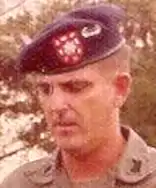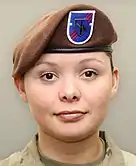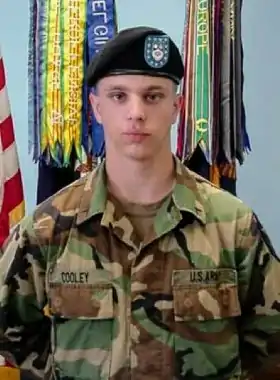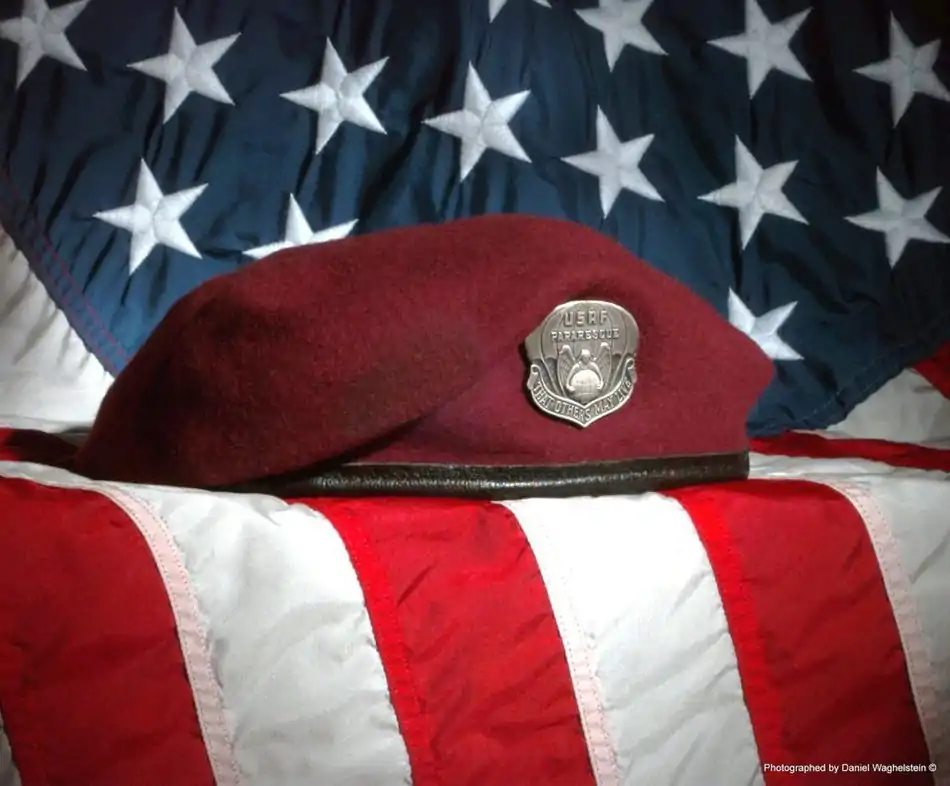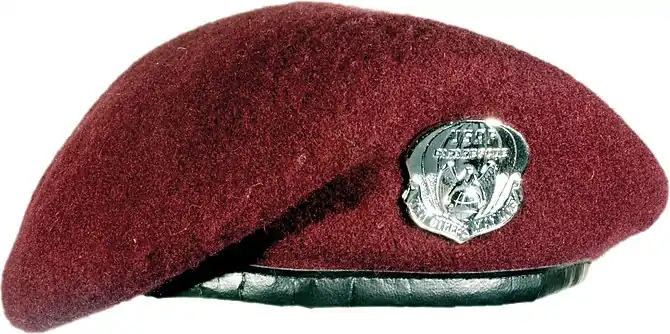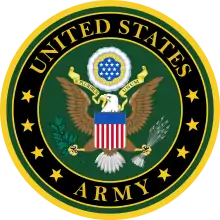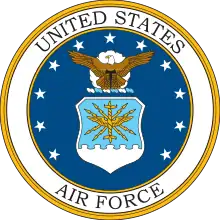United States military beret flash
In the United States (US) armed forces of today, a beret flash is a shield-shaped embroidered cloth or large polished metallic insignia that is usually attached to a stiffener backing of a military beret. The attached beret flash is worn over the left eye of the wearer with the excess cloth of the beret shaped, folded, and pulled over the right ear giving it a distinctive appearance.[1][2] The embroidered designs of the Army's beret flashes represent the distinctive heraldic colors and patterns of units with unique missions or represent the Army overall while the Air Force's represent their Air Force Specialty Code (AFSC) or their assignment to a unit with a unique mission.[2][3] Joint beret flashes, such as the United Nations Beret Flash—attached to the United Nations Peacekeepers ligh-blue beret—the Multinational Force and Observers Beret Flash—attached to a terracotta-colored beret—and the Joint Communications Support Element Beret Flash—attached to a maroon beret—are worn by all or most of the US armed forces while assigned to a specific joint units.[4][5][6]

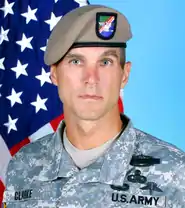


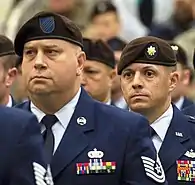
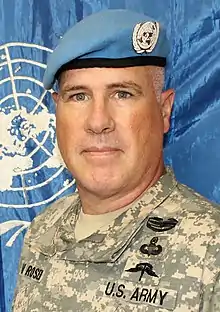

With the exception of joint beret flashes and some one-off wear requirements, Army soldiers and Non-Commissioned Officers (NCOs) attach their Distinctive Unit Insignia (DUI) to the beret flash.[1] Army warrant officers and commissioned officers attach their polished metal rank insignia to their beret flash while chaplains attach their polished metal branch insignia.[1] Air Force commissioned officers in the Security Forces or assigned to a Combat Aviation Advisor (CAA) squadron (SQN) wear their beret flash in the same manner as the Army.[2][7] Other Air Force commissioned officers in the Tactical Air Control Party (TACP) AFSC and those authorized large metallic beret flashes attach a miniature version of their polished metal rank insignia below their beret flash or crest.[2] Air Force airman and NCOs only wear their large metallic beret flash, cloth beret flash, or cloth beret flash with crest on AFSC or unit specific berets.[2][7]
US Department of Defense beret flash history
Department of the Army
Throughout its history, Army soldiers and their units have adopted different headgear and headgear devices—such as color accoutrements, insignias, and flashes—signifying special capabilities and unique roles of soldiers and their units.[9][10] An example of this tradition started in World War II with the adoption of airborne insignias which were authorized for wear by military parachutists and glider-born forces on specific assignments and by those assigned to airborne units.[11][12] The airborne insignias were worn on the left-side front (for enlisted and NCOs) or right-side front (for officers) of the former Army service uniform's service cap.[11][12] Different variants of airborne insignias were worn until later in World War II when parachute and glider formations combined their unit-specific insignias into one red, white, and blue Airborne Insignia.[13] Although airborne units began to wear the maroon beret as their official headgear in the 1980s, the service cap with Airborne Insignia continued to be authorized for wear until the black beret became the standard Army headgear in 2000.[12][14][15]
Other examples of this tradition can be seen with the adoption of organizational beret flashes worn to signify a specific formation of a specialized unit, such as a combat advisor, airborne, ranger, or special forces unit.[3][9][15] It is not clear when organizational beret flashes began to be used by the Army. However, historical Army films and photographs suggest the modern–day organizational beret flash may have been introduced in late 1961, around the time the green beret was officially authorized for wear by members of the Army's special forces.[16][17][18][19][20][21] Prior to that time, the green beret was worn informally by those assigned to special forces units who used their Parachutist Badge as their beret flash. The Parachutist Badge was worn high on the beret positioned either over the left eye or left temple and officers would wear their polished metal rank insignia below their badge.[16] As these special forces units began to adopt their organizational beret flashes, they also adopted rules as to who in their unit would be allowed to wear them.[22] For example, only special operations qualified paratroopers were authorized to wear their special forces unit's organizational beret flash while none-qualified soldiers wore a cloth recognition bar, color and pattern matched to their unit's organizational beret flash, below their DUI or officer rank insignia.[10][22][23]
 Basic Parachutist Badge 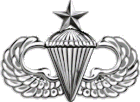 Senior Parachutist Badge |
 Part of a special forces detachment with the 8231st Army Unit, US Army Forces, Far East[24][25] wearing green berets with their Parachutist Badge attached—note the two officers (upper-right) wearing their rank insignia below their badge—c. 1956[16] |
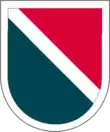 11th Special Forces Group Beret Flash—note similarities with the recognition bar depicted below 11th Special Forces Group Recognition Bar |
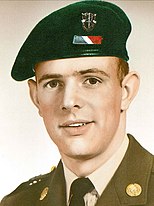 A medical corps paratrooper with the 11th Special Forces Group wearing green beret with 1st Special Forces DUI above his unit's recognition bar, c. 1967[26] |
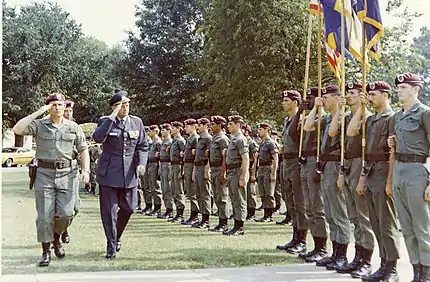
Other beret accouterments began to appear in the 1960s and 70s, particularly between 1973 and 1979 when the Department of the Army's (DA) morale-enhancing order was in effect and various colored berets began to be worn my numerous units and branches of the Army.[20][21][28] Historical photographs from the 1960s through the 1970s show soldiers assigned to Long-Range Reconnaissance and Patrol units wearing black berets with a wide variety of patches, tabs, and devices that were used as their beret flash (see Example 1).[28] Also during this time-period, some paratroopers and rangers assigned to certain training units would wear their Airborne Tab or Ranger Tab on a black beret above their DUI, Parachutist Badge, or rank insignia (see Example 2).[28][29] In 1975, the Army authorized its ranger units to wear the black beret with some of these units continuing to attach their Ranger Tab to their beret by sewing it on top of their new organization beret flash.[28][30] In 1973, Army leaders authorized the wear of the maroon beret by airborne units.[28] Historical photographs of these paratroopers in the 1970s show them wearing their Parachutist Badge on their maroon beret, just as members of special forces had done on their green berets in the 1950s, but with their unit's background trimming—which made their debut in World War II[31]—and officer or NCO polished metal rank insignia below it (see Example 3).[3][16][28][32] Paratroopers of the 82nd Airborne Division (Div) wore their maroon berets differently with historical photographs from 1973 through 1977 showing 82nd Airborne Div paratroopers attaching their DUIs and eventually adding traditionally styled regiment (RGT) and/or battalion (BN) specific organizational beret flashes—pattered after their unit's background trimming—and worn in the same manner as they are today.[1][27][33][34] Similarly, in 1974 Army leaders authorized the 101st Airborne Div to wear the dark-blue beret[8][28]—the same year the unit was redesignated as an air assault division.[35] Army articles and historical photographs of 101st soldiers show them wearing the same traditionally styled organizational beret flashes as the 82nd—also patterned after their unit's background trimming—but with enlisted attaching their DUI and NCO and officers attaching their polished metal rank insignia. Between 1976 and 1977, 101st soldiers would add their Airmobile Badge—renamed Air Assault Badge in 1978[36]—to their berets and wore them to the left of the wearer's beret flash (see Example 4).[8][28][37] Additionally, US Army armored cavalry RGTs stationed in West Germany began wearing locally authorized black berets in the 1970s with a cloth maroon and white elongated oval as their beret flash.[20][21][28] These armored cavalry unit soldiers wore the oval vertically behind their DUI, to the left of the wearer's metal rank insignia (enlisted, NCOs, and officers alike), and positioned over their left temple (see Example 5).[20][21][28][38] Also during the 1970s, arctic-qualified soldiers of the 172nd Infantry Brigade (BDE) began to wear locally authorized olive-drab berets with traditionally styled organizational beret flashes that were hand-made, unique to each BN, and were worn in the same manner as they are today (see Example 6).[1][21][28] The aforementioned Army articles and historical photographs also describe and show the use of unique Army branch specific berets that were worn by some soldiers in the 1970s which were dyed to match the heraldic colors of their branch.[20][21] Enlisted soldiers attached their regimental insignia while officers attached their polished metal rank insignia on these branch-specific berets for used as their beret flash.[20][21][28] By 1979, the Army put a stop to the use of berets by conventional forces, leaving only special forces and ranger units the authority to wear berets.[20][21][28]
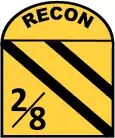



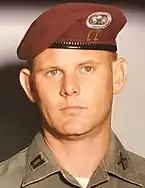
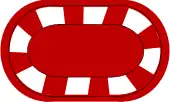

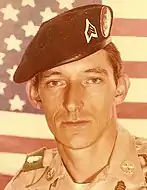
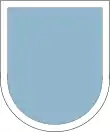

In 1980, the Army reversed part of its decision allowing airborne units to wear maroon berets, ranger units black berets—which switched to tan berets in 2001[21]—and special forces units green berets.[20][21][39] The Army's 1981 uniform regulation describes the wear of these newly approved berets with the only authorized accoutrements being officer rank insignias, DUIs, organizational beret flashes, and recognition bars.[10][40] The organizational beret flash did not become the norm until 1984 when the recognition bar was discontinued after the Special Forces Tab became authorized for wear by special forces qualified paratroopers and all members assigned to a special forces unit, regardless of their qualifications, began to wear their unit's organizational beret flash.[22]
In 2000, General Eric Shinseki, Chief of Staff of the Army, decided to make the black beret the standard headgear of the Army; General Shinseki also decided that a new DA Beret Flash will be worn by all units that do not have an organizational beret flash.[1][21][45][46] Army units can request an organizational beret flash for their formation—as was authorized for the Army's new Security Force Assistance Command (SFAC) and its BDEs (a.k.a. SFABs)—given it is not for wear on the black beret.[3][41][42][47][48][49][50][51][52][53] According to Pam Reece of The US Army Institute of Heraldry (TIOH), the DA Beret Flash "is designed to closely replicate the colors of the Commander-in-Chief of the Continental Army at the time of its victory at Yorktown."[21][54]
The design of each unit's organizational beret flash was created and/or approved by TIOH.[45] TIOH based their original organizational beret flash designs after a unit's existing background trimming.[3] For newer units authorized an organizational beret flash, TIOH will research the requesting unit's heraldry leveraging geometrical divisions, shapes, and colors to represent the history and mission of the unit in the creation of a design.[55][41] Once the requesting unit agrees upon a design, TIOH creates manufacturing instructions and conducts quality control for companies authorized to produce the organizational beret flash.[55][56][57]
Department of the Air Force
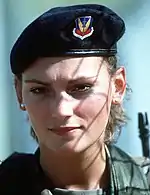
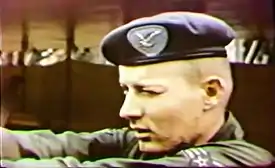
In 1957, the Strategic Air Command (CMD) Elite Guard was the first Air Force unit authorized to wear berets. The first beret flash worn on the unit's navy-blue beret was a metal full-color replica of the Strategic Air CMD Shield.[60][61] In 1966/67, the newly formed 1041st Security Police SQN was authorized to wear a different shade of dark-blue beret and used a depiction of a falcon carrying a pair of lightning bolts on a light-blue cloth patch as their beret flash.[62][59][63] In 1976, the Air Force approved the navy-blue beret, worn by Strategic Air CMD's Elite Guard and Air Force Combat Control Teams, as the official uniform item for all Air Force police and security forces.[62][64] The beret flash used on these berets was a metal full-color replica of the airman's major CMD shield.[65][58] In 1997, the Air Force stood up the security forces AFSC and honored the heraldry of the 1041st Security Police SQN by creating a new cloth beret flash for all security forces airman and NCOs that depict the 1041st's falcon over an airfield with the motto "Defensor Fortis" (defenders of the force) embroidered on a scroll at its base.[2][62] Security forces officers wear the same basic beret flash minus the embroidered falcon and airfield and in its place attach their polished metal rank insignia.[2]
Historical photographs from 1964 through the 1970s show combat controllers wearing navy–blue berets.[66][67] Initial wear of these berets followed the trend of special forces units whereby combat controller's wore their Parachutist Badge over their left eye acting as their beret flash with officers wearing their polished metal rank insignia below their badge; yet other combat controllers wore these berets with their Parachutists Badge and polished metal rank insignia (enlisted, NCO, and officer alike) over their right temple with the excess of the beret's material pulled over the left hear.[16][66][67] The navy-blue beret was officially approved for wear by combat controllers in 1973.[68] In 1978 they received authorization to wear scarlet berets with a large metallic Combat Control Beret Flash, created by retired combat controllers Jack Hughes and Gene Adcock.[64][69] The combat controllers first beret flash was an unpolished metal circular disc surrounded by a wreath with a scroll at its base with the embossed words "Combat Control Team" and a lightning built diagonally splitting the center of the disc with a compass rose on the bottom-right half and a parachute on the upper-left half toped with the embossed phrase "First There."[69][70] The new scarlet beret and beret flash were worn in the same manner as it is today with the flash centered over the left eye and the excess cloth of the beret pulled over the right ear.[2][64][71] In 1984 the shape of the Combat Control Beret Flash was modified with some of its elements rearranged, a gridded globe added to its center, and the scroll changed to read "U.S.A.F. Combat Control; this new polished metal version is what the Combat Controllers wear today.[69][72] Special tactics officers also wear the scarlet beret and wear their miniature polished metal rank insignia just below a visually similar beret flash to the combat controllers but contains different symbols and phrases representing the different AFSCs they oversee and support: a compass rose for combat control, a guardian angel protecting the Earth for pararescue, a dagger with crossed lightning bolts for special reconnaissance, and a falcon for security forces all depicted in-front of a gridded globe flanked by wreaths with a scroll at its base with the phrases "USAF Special Tactics" and "Mal Ad Os" (bad to the bone) as well as a banner atop of the flash that contains the phrases "First There" and "That Others May Live."[2][73][74]
 A Combat Control NCO with the 7th Aerial Port SQN wearing navy-blue beret with his Senior Parachutist Badge and rank insignia, 1964[66] |
In 1966, Air Force pararescuemen, also known as a Pararescue Jumper (PJ), were authorized to wear the maroon beret and a large metallic Pararescue Beret Flash.[68][75] The color of the beret (maroon) was chosen to symbolize the sacrifice required of PJs and its initial wear followed the trend of the time whereby PJs used their Parachutist Badge as their beret flash due to perceived gaps in production and distribution of the Pararescue Beret Flash.[16][75][68][76] The Pararescue Beret Flash was derived from the Air Rescue Service shield—which was designed by TSgt Bill Steffens (Retired)[77]—and consists of a guardian angel wrapping its arms around the Earth, which symbolizes the mission of the PJ, surrounded by a parachute mounted on a banner that has the phrase, "That others may live," embossed on it, the PJ creed.[78] Combat rescue officers wear a modified version of the Pararescue Beret Flash with the word "Pararescue" replace with "Combat Rescue Officer" and is worn just above their miniature polished metal rank insignia on the same maroon beret as the PJs.[2][74]
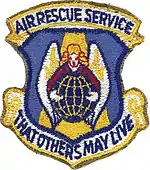 Original Air Rescue Service Shield |
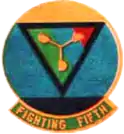
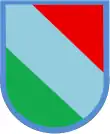
In the mid 1960s, Air Force commando weathermen,[79] formally known as weather parachutists, with Detachment 26 of the 30th Weather SQN and Detachment 32 of the 5th Weather SQN informally wore black berets.[80] The beret flash worn on these berets was a black cloth rectangle with a depiction of a yellow embroidered anemometer surmounted by a fleur-de-lis with the words “Combat Weather” split by the anemometer.[80] In 1963, weather parachutists from Detachment 75 of the 2nd Weather Group wore gray berets and like the PJs and combat controllers of the era used their Parachutist Badge as their beret flash and worn their polished metal rank insignia (enlisted, NCO, and officer alike) just below their badge.[67][75][80] From 1970 through the 1980s, weather parachutists with the 5th Weather SQN wore maroon berets with an Army style beret flash that incorporated the SQN's colors from their emblem's alchemical symbol for water—the green, blue, and red colors representing Earth, air, and fire respectively—and wore their Parachutist Badge attached to the flash.[41][80] In 1979, weather parachutists, now called Special Operations Weather Teams (SOWTs), were authorized to wear navy-blue berets with an Army style beret flash consisting of a blue and black field surrounded by yellow piping.[41][80] Enlisted and NCOs wore their Parachutist Badge attached to the flash while officers wore their polished metal rank insignia.[80] In 1986, the gray beret was authorized for wear by all SOWTs who continued to wear the aforementioned cloth beret flash until a new large color metallic SOWT Beret Flash was authorized.[80] This large metallic beret flash used the same color field as the previous cloth beret flash but had a parachute with the letters "USAF," a dagger, and crossed lightning bolts centered on the field with a scroll at the bottom embossed with the words “Air Weather Service;” this metal beret flash was surrounded by a gilded band embossed with the words “Special Operations Weather Team."[80] In 1992, the Air Force approved the return of the SOWT's blue, black, and yellow cloth beret flash from the 70s and used their color metallic SOWT Beret Flash from the 80's as their beret crest (i.e. it was placed on top of the cloth beret flash).[80] In 1996, the SOWTs assigned to the US Air Force Special Operations CMD (AFSOC) wore a new Army style beret flash while those assigned to Air Combat CMD, known as Combat Weather Teams (CWTs), continued to wear the original blue, black and yellow beret flash.[41][80][81] The AFSOC SOWT Beret Flash consisted of a red border representing the blood shed by their predecessors, a black background represented special operations, and three diagonal lines of various colors representing the services they supported (green=Army, purple=joint forces, and blue=Air Force).[80] Enlisted and NCOs wore their Parachutist Badge on top of the AFSOC SOWT Beret Flash while officers wore their polished metal rank insignia until 2002 when the Combat Weather Team Crest was created.[80] The Combat Weather Team Crest incorporated the center elements of the 1986 metallic SOWT Beret Flash/Crest—specifically the parachute, crossed lightning bolts, and dagger—with arched banners embossed with "Combat Weather Team" above, "Airborne" below, and "USAF" in a center rectangular banner.[80] The Combat Weather Team Crest was worn attached on both SOWT and CWT Beret Flashes by enlisted and NCOs while officers continued to wear their polished metal rank insignia.[80][82][83] In 2007/2008, the AFSOC SOWT Beret Flash stopped being worn and the Combat Weather Team Crest became the de facto beret flash for these units.[80][82][84] In 2009—when the Special Operations Weather AFSC was established—a new large polished metallic Special Operations Weather Beret Flash was approved for wear by all SOWTs and CWTs (enlisted, NCOs, and officers alike) but took an additional year to create and was worn in the same manner as the modern-day Combat Control and Pararescue Beret Flashes.[2][80][84][85] In 2019, SOWTs were re-designated special reconnaissance so the name embossed on the Special Operations Weather Beret Flash was changed to "SPECIAL U.S.A.F. RECON" and the fleur-de-lis was removed, otherwise this last variant of the SOWT's beret flash remains the same.[86][87]
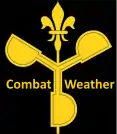

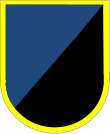
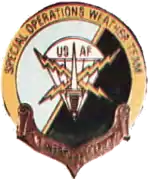
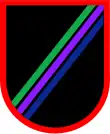
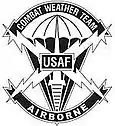
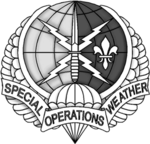
Variations in wear of the Combat Weather Team Crest between 2002–2010 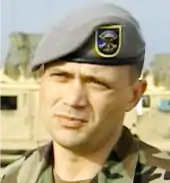 A weather parachutist NCO with the Army's 82nd Airborne Div wearing the CWT Beret Flash with Combat Weather Team Crest, 2007[88] 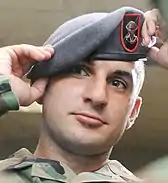 A weather parachutist with the 107th Weather Flight wearing SOWT Beret Flash with Combat Weather Team Crest, 2008[82]  A weather parachutist with the 320th Special Tactics SQN wearing Combat Weather Team Crest as beret flash, 2010[89] |
In 1979, TACP's were given authorization to wear the black beret. In 1984, two TACP's submitted a design for a unique beret flash and crest for wear on their berets.[20] The Air Force approved the TACPs' flash and crest design in 1985.[20] The TACP Beret Flash—which followed the basic design language of Army beret flashes[41]—incorporates red borders that represent the firepower TACP's bring to bear with two dovetailed fields of blue and green represent the close working relationship between the Air Force and the Army that is enabled by the TACP.[90] The TACP Crest incorporates am arched banner at its top embossed with "U.S. Air Force" held up by erect–wings which symbolize the combat readiness of the TACP, at its center is a sword symbolizes the firepower controlled by the TACP, a lightning bolt representing modern–day communications used by the TACP, an eight-point star symbolizes the worldwide mobility of the TACP, and at the crest's base is a rectangular banner embossed with the letters "TACP."[90] Latter, Air Liaison Officers (ALOs) were given authorization to wear the black beret and the TACP Beret Flash, no crest.[20][91][92] In 2019 the Air Force uniform instruction changed directing ALOs, now called TACP Officers, to wear the TACP Beret Flash and Crest with miniature polished metal rank insignia below the crest and just above the outer-border of the beret flash.[2][93][94] Similarly, Air Mobility Liaison Officers (AMLOs) also wore the black beret.[20] Although worn informally before then, in 2015 TIOH authorized a slight modification of the TACP Beret Flash for wear by AMLOs, incorporating an embroidered compass rose in the upper-left corner of the beret flash, and was worn in the same manner as Army beret flashes.[1][2][95][96] Despite this, the Air Force Uniform Board and uniform regulations do not address the wear of the AMLO Beret Flash by these liaisons.[2]
 TACP Beret Flash without crest, worn by ALOs 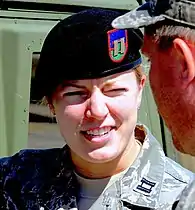 An ALO with the 682 Direct Air Support Operations SQN wearing black beret with TACP Beret Flash and rank insignia, 2011[97] |
 TIOH manufacturing instructions for the AMLO Beret Flash 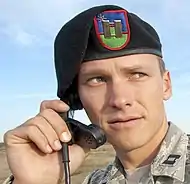 An AMLO with the 8th Air Support Operations SQN wearing black beret with AMLO Beret Flash and rank insignia, 2011[95] |

In 2004, the Air Force authorized the wear of the pewter-green beret to graduates of the US Air Force Survival, Evasion, Resistance and Escape (SERE) Specialist Technical School.[99] The beret flash worn on these berets is a polished metallic shield embossed with a bald eagle in front of a compass rose with barbed wire in the foreground, a scroll at the top embossed with "USAF SERE," and the SERE motto "Return With Honor" embossed at its base.[99] The SERE Specialist Beret Flash is worn centered over the left eye.[2]
In 2018, AFSOC authorized the wear of the brown beret for airman, NCOs, and officers assigned to a CAA unit, specifically the 6th and 711th Special Operations SQNs. The brown beret is worn with an Army style cloth beret flash consisting of a dark-blue field with olive-green diagonal stripes and border.[41][100] The CAA Beret Flash is worn centered over the left eye with AFSC specific metallic beret flashes or polished metal officer rank insignia attached while all other advisors wear the cloth CAA Beret Flash without accoutrements.[100]
Department of the Navy
In the 1960s, select Navy riverine patrol units operating in South Vietnam adopted the black beret to be part of their daily uniform and wore various accouterments on their berets.[102] In 1967, the Commander of the Riverine Patrol Force sent an official message to the Commander of River Patrol Flotilla Five authorizing the wear of the black beret.[102] In this message, the wear and appearance of the beret was also defined stating, "Beret will be worn with river patrol force insignia centered on right side." and "Only standard size river patrol force insignia will be worn on beret. ... No other emblem or rank insignia will be displayed on beret."[102][103] Today, these Navy small boat units honor their heritage by wearing the black beret during special occasions—such as induction ceremonies into the Gamewardens Association[104]—and will affix historically relevant riverine task force insignia for use as their beret flash.[107]
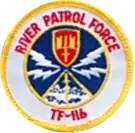
.jpg.webp)

By the early 1970s, some of the US Marines remaining in South Vietnam were combat advisers supporting the Republic of Vietnam Marine Div, also known as the South Vietnamese Marine Corps (VNMC).[110] Those Marine advisers wore a derivative of the NVMC combat uniform.[110] Many of these Marine advisors wore VNMC green berets with a metallic version of the VNMC Beret Flash and wore it over their right temple with the excess cloth of the beret pulled over their left ear.[110][111]

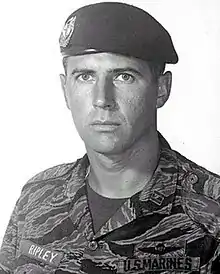
Female service uniform beret devices
Starting in the 1970s, a special female beret was authorized for wear as alternate headgear for the Army, Air Force, Navy, and Marine Corps with various service uniforms.[10][112][113] The Navy was the last service to remove the female beret from their uniform regulations in 2015.[115] These black (Army and Navy), dark-blue (Air Force), and dark-green (Marine Corps) female berets were of similar design and worn on the crown of the head.[10][112][113][116] These service members wore their traditional cap devices on these female berets but unlike today's Army and Air Force beret flashes, these devices were worn center-forward on the beret with the exception being the Navy who wore their devices centered over the left eye.[10][112][113][116]
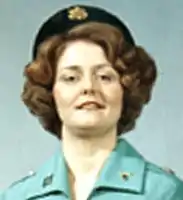
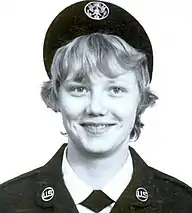

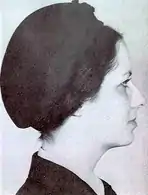
Army commissioned officers wore a gold metal replica of the coat of arms of the United States on their female berets[10] while Air Force commissioned officers, commissioned warrant officers, and warrant officers wore a silver version of the same insignia.[118] Army commissioned warrant officers and warrant officers wore a gold metal spread–eagle enclosed within a wreath on their female berets.[119] Army and Air Force enlisted and NCOs wore a gold (Army) or silver (Air Force) metal replica of the coat of arms of the United States surrounded by a like-colored metal ring on their female berets.[10][112]
Navy commissioned officers and commissioned warrant officers wore a silver spread–eagle surmounting a silver escutcheon with gold fouled anchors on their female berets while warrant officers wore only the gold fouled anchors until commissioned. Navy enlisted and NCOs wore a silver spread–eagle with the letters "USN" mounted above the wings on their female berets while more senior NCOs (E-7/OR-7 through E-9/OR-9) wore their polished metal collar rank insignia.
Marines wore a subdued version of the Eagle, Globe, and Anchor Emblem centered on their female beret.[113] Commissioned officers, commissioned warrant officers and warrant officers wore a version of the emblem that had a more intricate design compared to what was worn by enlisted and NCOs.[113]
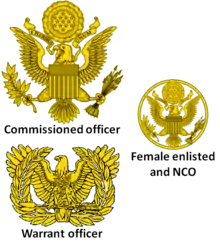
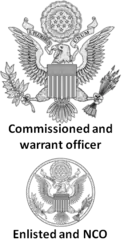
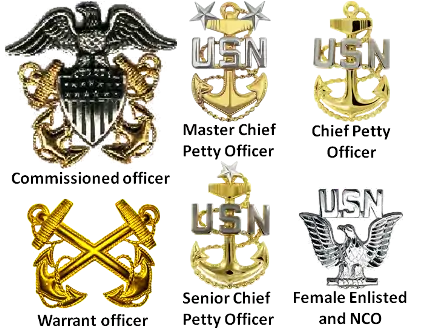
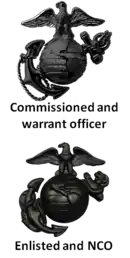
Beret flashes of the US military
Joint
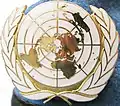
United Nations 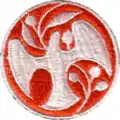
Multinational Force and Observers (cloth variant)
Joint Air Force and Army
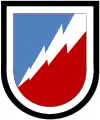
Joint Enabling Capabilities CMD's Joint Communication Support Element 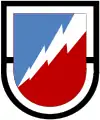
Joint Enabling Capabilities CMD, Joint Communication Support Element's 1st SQN 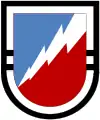
Joint Enabling Capabilities CMD, Joint Communication Support Element's 2nd SQN 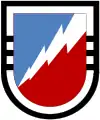
Joint Enabling Capabilities CMD, Joint Communication Support Element's 3rd SQN 
Joint Enabling Capabilities CMD, Joint Communication Support Element's 4th SQN 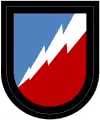
Joint Enabling Capabilities CMD, Joint Communication Support Element's Communications Support Detachment
- Obsolete joint Air Force and Army
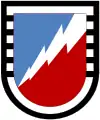
Joint Enabling Capabilities CMD, Joint Communication Support Element's 5th SQN
Air Force
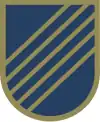
CAA 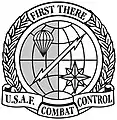
Combat Control 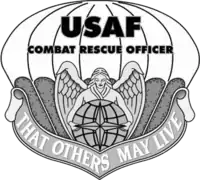
Combat Rescue Officer 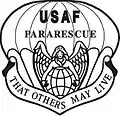
Pararescue 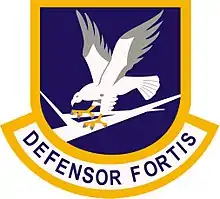
Security Forces 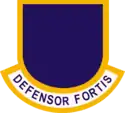
Security Forces Officer 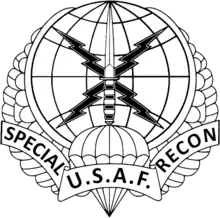
Special Reconnaissance 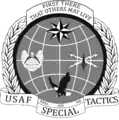
Special Tactics Officer 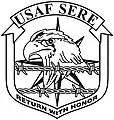
SERE Specialist 
TACP and TACP Officer 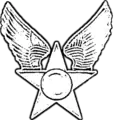
US Air Force Junior Reserve Officers' Training Corps
- Obsolete security forces
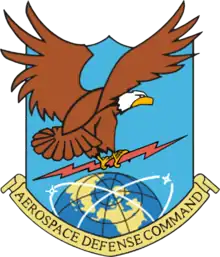
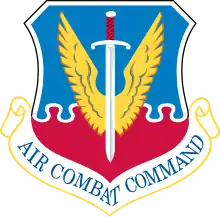
Air Combat CMD 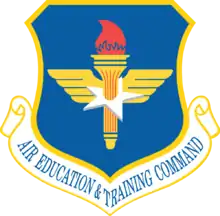
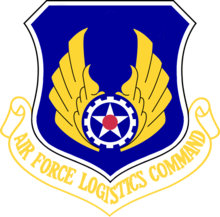
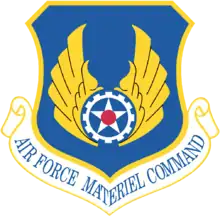
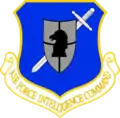
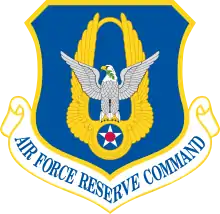

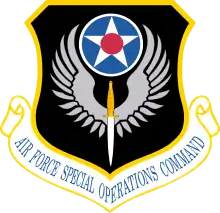
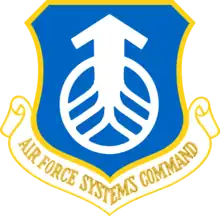
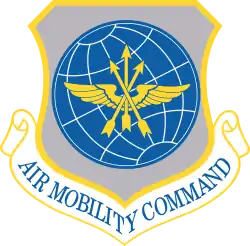
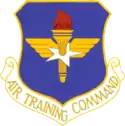
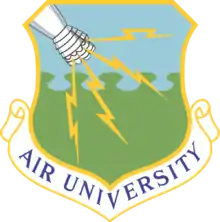
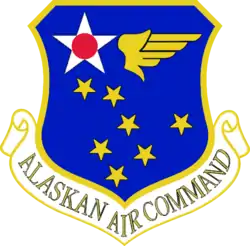
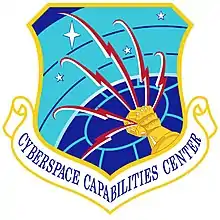
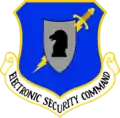
Electronic Security CMD 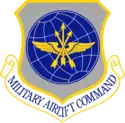

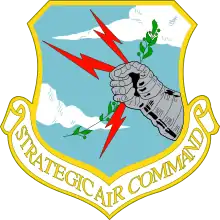
Strategic Air CMD 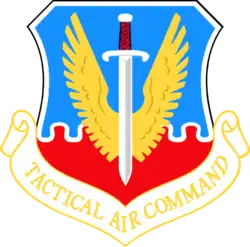
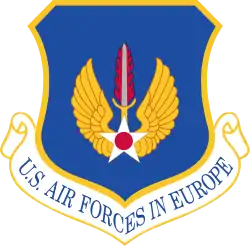

1041st Security Police SQN
- For other obsolete beret flashes, see the Department of the Air Force history section above.
Army
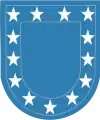
DA (worn when no organizational beret flash exists)
Adjutant general and public affairs
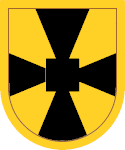
US Army Recruiting CMD, Marketing and Engagement BDE's US Army Parachute Team 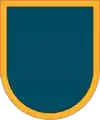
82nd Airborne Div's 49th Public Affairs Detachment
- Obsolete adjutant general and public affairs
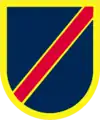
XVIII Airborne Corps's 18th Personnel Group 
82nd Airborne Div's 82nd Finance BN 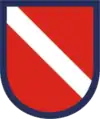
82nd Airborne Div's 82nd Personnel Services BN
Air defense and field artillery
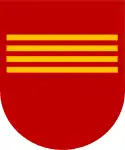
US Army Europe and Africa (USAREUR-AF), 173rd Airborne BDE, 319th Field Artillery RGT's 4th BN 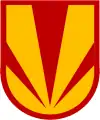
XVIII Airborne Corps, 108th Air Defense Artillery BDE, 4th Air Defense Artillery RGT, 3rd Bn's E Battery 

82nd Airborne Div's 82nd Airborne Div Artillery
as well as
former 101st Airborne Div's 101st Div Artillery
82nd Airborne Div, 1st BCT, 319th Field Artillery RGT's 3rd BN 
82nd Airborne Div, 2nd BCT, 319th Field Artillery RGT's 2nd BN 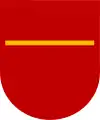
82nd Airborne Div, 3rd BCT, 319th Field Artillery RGT's 1st BN
- Obsolete air defense and field artillery
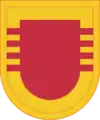
US Army Alaska, 172nd Infantry BDE, 501st Infantry RGT, 1st Bn, 11th Field Artillery RGT's 4th Bn, C Battery 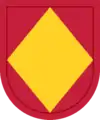
XVIII Airborne Corps Artillery's Headquarters and Headquarters Battery 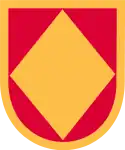
XVIII Airborne Corps' 18th Field Artillery BDE 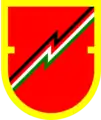
XVIII Airborne Corps, 18th Field Artillery BDE's 1st Field Artillery Detachment 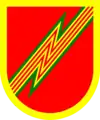
XVIII Airborne Corps, 18th Field Artillery BDE's 234th Field Artillery Detachment 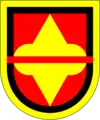
XVIII Airborne Corps, 18th Field Artillery BDE, 321st Field Artillery RGT's 1st Bn 
XVIII Airborne Corps, 18th Field Artillery BDE, 377th Field Artillery RGT's 1st Bn 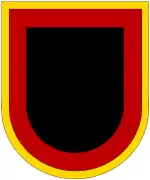
82nd Airborne Division, 4th BCT, 321st Field Artillery RGT's 2nd Bn 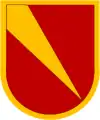
101st Airborne Div, 3rd Air Defense Artillery RGT's 1st BN
Armor and cavalry
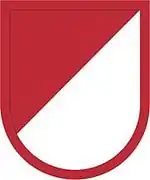
USAREUR-AF, 173rd Airborne BDE, 91st Cavalry RGT's 1st SQN 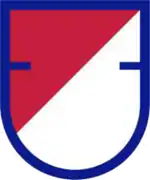
25th Infantry Div, 4th BCT, 40th Cavalry RGT's 1st SQN 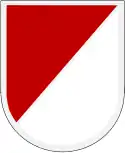
82nd Airborne Div, Combat Aviation BDE (CAB), 17th Cavalry RGT's 1st SQN 
82nd Airborne Div, 1st BCT, 73rd Cavalry RGT's 3rd SQN 
82nd Airborne Div, 2nd BCT, 73rd Cavalry RGT's 1st SQN 
82nd Airborne Div, 3rd BCT, 73rd Cavalry RGT's 5th SQN
- Obsolete armor and cavalry
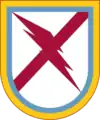
Alabama Army National Guard, 142nd Battlefield Surveillance BDE (BfSB), 131st Cavalry RGT, 1st SQN's C Troop 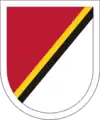
Maryland Army National Guard, 58th BfSB, 158th Cavalry RGT, 1st SQN's C Troop 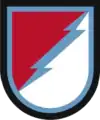
Texas Army National Guard, 71st BfSB, 124th Cavalry RGT, 3rd SQN's C Troop 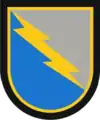
I Corps, 201st BfSB, 38th Cavalry RGT's C Troop 
I Corps, 201st BfSB, 38th Cavalry RGT, 3rd SQN's C Troop 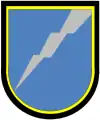
III Corps, 504th BfSB, 38th Cavalry RGT, 2nd SQN's C Troop (original version) 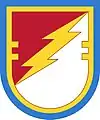
III Corps, 504th BfSB, 38th Cavalry RGT, 2nd SQN's C Troop 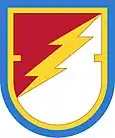
XVIII Airborne Corps, 525th BfSB, 38th Cavalry RGT, 1st SQN's C Troop 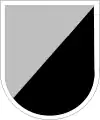
35th Infantry Div, 167th Cavalry RGT, 1st SQN's Long-Range Surveillance Detachment 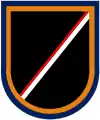
40th Infantry Div, 79th BCT, 18th Cavalry RGT, 1st SQN's Long-Range Surveillance Detachment 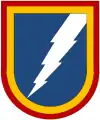
42nd Infantry Div, 27th BCT, 101st Cavalry RGT, 2nd SQN's Long-Range Surveillance Detachment 
42nd Infantry Div, 117th Cavalry RGT, 5th SQN's Long-Range Surveillance Detachment 
82nd Airborne Div, 1st BCT, 68th Armor RGT, 4th BN's A Co;
82nd Airborne Div, 73rd Armor RGT's 3rd BN;
and US Army Europe, 173rd Airborne BDE, 16th Armor RGT's D Co
82nd Airborne Div, 4th BCT, 73rd Cavalry RGT's 4th SQN 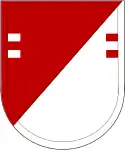
101st Airborne Div, CAB, 17th Cavalry RGT's 2nd SQN
Aviation
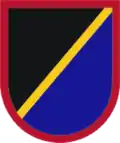
US Army Special Operations Aviation CMD (USASOAC) 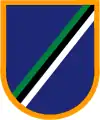
USASOAC's 160th Special Operations Aviation RGT 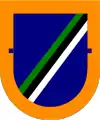
USASOAC, 160th Special Operations Aviation RGT's 1st BN 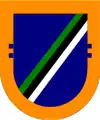
USASOAC, 160th Special Operations Aviation RGT's 2nd BN 
USASOAC, 160th Special Operations Aviation RGT's 3rd BN 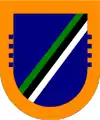
USASOAC, 160th Special Operations Aviation RGT's 4th BN 
82nd Airborne Div's CAB 
82nd Airborne Div, CAB, 82nd Aviation RGT's 1st BN 
82nd Airborne Div, CAB, 82nd Aviation RGT's 2nd BN 
82nd Airborne Div, CAB, 82nd Aviation RGT's 3rd BN
- Obsolete aviation

US Army Europe, 11th Aviation BDE's Pathfinder Platoon 
US Army Special Operations CMD's 160th Aviation Group 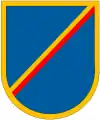
US Army Special Operations CMD, 245th Special Operations Aviation RGT's 1st BN 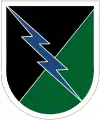
Special Operations CMD South's 617th Special Operations Aviation Detachment 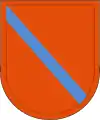
1st Special Forces's 22nd Aviation Detachment 
1st Special Forces, 22nd Aviation Detachment's Recognition Bar 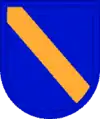
V Corps, 12th Aviation Brigade's Pathfinder Platoon 
Eighth US Army, 17th Aviation BDE's Pathfinder Platoon 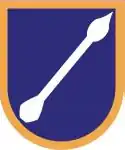
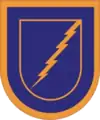
XVIII Airborne Corps, 58th Aviation RGT's 1st BN 
XVIII Airborne Corps's 229th Aviation Group 
82nd Airborne Div's 82nd Aviation BDE 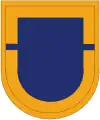
82nd Airborne Div, 82nd Aviation RGT's 1st BN (original version) 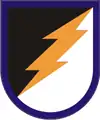
82nd Airborne Div, 82nd Aviation RGT's 1st BN (second version) 
82nd Airborne Div, 82nd Aviation RGT's 2nd BN (original version) 
82nd Airborne Div's 82nd Combat Aviation BN 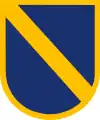
101st Airborne Div, CAB's 101st Aviation RGT
as well as
1st Special Forces' 44th Chemical Detachment
Chemical and logistics

Arctic Support CMD, 17th Combat Sustainment Support BN's 4th Quartermaster Detachment 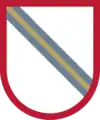
Defense Logistics Agency's Defense Distribution Depot-Army Element 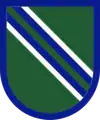
General Lucius D. Clay National Guard Center's 165th Quartermaster Co 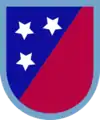
Program Executive Office's Airborne Procurement Team 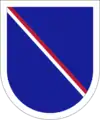
US Army Test and Evaluation CMD, Yuma Proving Ground's Airborne Test Force 
3rd Expeditionary Sustainment CMD, 264th Combat Sustainment Support BN's 647th Quartermaster Co 
20th Chemical, Biological, Radiological, Nuclear, and high–yield Explosives (CBRNE) CMD, 52nd Ordnance Group, 192nd Ordnance BN's 28th Ordnance Co 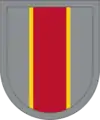
20th CBRNE CMD, 52nd Ordnance Group, 192nd Ordnance BN's 722nd Ordnance Co 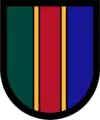
20th CBRNE CMD, 52nd Ordnance Group, 192nd Ordnance BN's 767th Ordnance Co 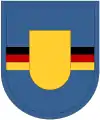
21st Theater Sustainment CMD, 16th Sustainment BDE, 16th Special Troops BN's 5th Quartermaster Theater Aerial Delivery Co 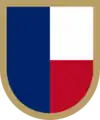
36th Infantry Div, 36th Infantry Div Sustainment BDE's 294th Quartermaster Co 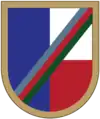
36th Infantry Div, 36th Infantry Div Sustainment BDE, 294th Quartermaster Co's 36th Quartermaster Detachment 
56th Troop CMD's 56th Quartermaster Detachment 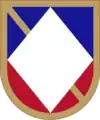
82nd Airborne Div, 82nd Airborne Div Sustainment BDE, 189th Combat Support Sustainment BN's 11th Quartermaster Co 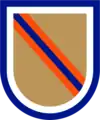
143rd Sustainment CMD, 518th Sustainment BDE, 275th Combat Sustainment Support BN's 470th Quartermaster Co 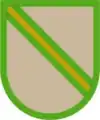
143rd Sustainment CMD, 518th Sustainment BDE, 275th Combat Sustainment Support BN's 824th Quartermaster Co 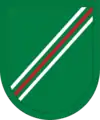
143rd Sustainment CMD, 518th Sustainment BDE, 352nd Combat Sustainment Support BN's 346th Quartermaster Co 
143rd Sustainment CMD, 518th Sustainment BDE, 352nd Combat Sustainment Support BN's 421st Quartermaster Co 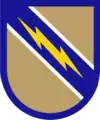
316th Sustainment CMD, 77th Sustainment BDE's 861st Quartermaster Co
- Obsolete chemical and logistics
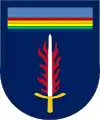
US Army Europe's 29th Transportation BN 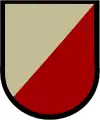
US Army Forces CMD's 561st Maintenance BN 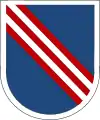
US Army Japan, 10th Regional Support Group, 35th Combat Sustainment Support BN's 87th Quartermaster Detachment 
1st Cavalry Div, 1st Cavalry Div Sustainment BDE's 527th Quartermaster Detachment 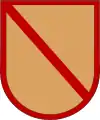
1st Corps Support CMD's 600th Quartermaster Co 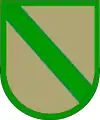
1st Corps Support CMD's 612th Quartermaster Co 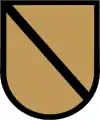
1st Corps Support CMD's 623rd Quartermaster Co 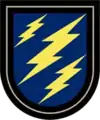
1st Special Forces, 5th Special Forces Group's 56th Chemical Reconnaissance Detachment 
1st Special Forces' 44th Chemical Detachment
as well as
101st Airborne Div, CAB's 101st Aviation RGT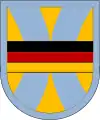
21st Theater Sustainment CMD, 16th Sustainment BDE, 16th Special Troops BN's 5th Quartermaster Theater Aerial Delivery Co (original version) 
82nd Airborne Div's 33rd Aviation Maintenance Co 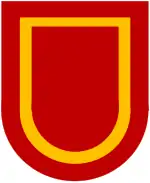
82nd Airborne Div's 407th Supply and Transportation BN (currently the 82nd Airborne Div, 2nd BCT's 407th BDE Support BN) 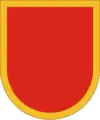
82nd Airborne Div, 4th BCT's 782nd Maintenance BN 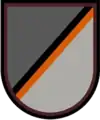
451st Expeditionary Sustainment CMD, 89th Sustainment BDE, 620th Combat Sustainment Support BN's 383rd Quartermaster Co
Civil affairs and psychological operations
_beret_flash.png.webp)
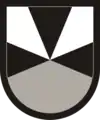
USACAPOC, 2nd Psychological Operations (PSYOP) Group, 15th PSYOP BN's 310th, 325th, and 346th Tactical PSYOP Cos 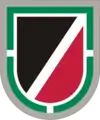
USACAPOC, 7th PSYOP Group, 14th PSYOP BN's 301st Tactical PSYOP Co 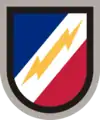
USACAPOC, 7th PSYOP Group, 17th PSYOP BN's 344th Tactical PSYOP Co 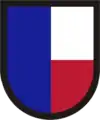
USACAPOC, 7th PSYOP Group, 17th PSYOP BN's 345th Tactical PSYOP Co 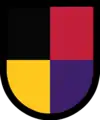
USACAPOC, 350th Civil Affairs CMD, 1st Training BDE's 478th Civil Affairs BN 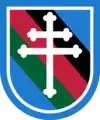
USACAPOC, 351st Civil Affairs CMD, 358th Civil Affairs BDE's 416th Civil Affairs BN 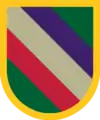
USACAPOC, 351st Civil Affairs CMD, 358th Civil Affairs BDE's 426th Civil Affairs BN 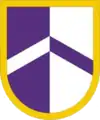
USACAPOC, 352nd Civil Affairs CMD's 360th Civil Affairs BDE 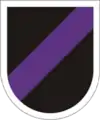
USACAPOC, 352nd Civil Affairs CMD, 360th Civil Affairs BDE's 412th Civil Affairs BN 
USACAPOC, 352nd Civil Affairs CMD, 360th Civil Affairs BDE's 450th Civil Affairs BN 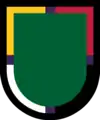
USACAPOC, 353rd Civil Affairs CMD, 304th Civil Affairs BDE's 404th Civil Affairs BN 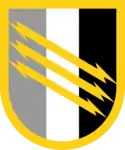
1st Special Forces CMD's 4th PSYOP Group 
1st Special Forces CMD, 4th PSYOP Group's 3rd PSYOP BN 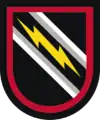
1st Special Forces CMD, 4th PSYOP Group's 7th PSYOP BN 
1st Special Forces CMD, 4th PSYOP Group's 8th PSYOP BN 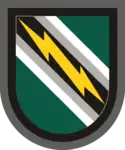
1st Special Forces CMD's 8th PSYOP Group 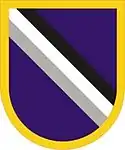
1st Special Forces CMD's 95th Civil Affairs BDE 
1st Special Forces CMD, 95th Civil Affairs BDE's 91st Civil Affairs BN 
1st Special Forces CMD, 95th Civil Affairs BDE's 92nd Civil Affairs BN 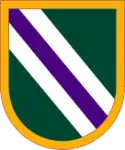
1st Special Forces CMD, 95th Civil Affairs BDE's 96th Civil Affairs BN 
1st Special Forces CMD, 95th Civil Affairs BDE's 97th Civil Affairs BN 
1st Special Forces CMD, 95th Civil Affairs BDE's 98th Civil Affairs BN
- Obsolete civil affairs and psychological operations
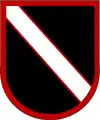
USACAPOC, 2nd PSYOP Group, 15th PSYOP BN's 310th Tactical PSYOP Co (original version) 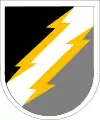
USACAPOC, 2nd PSYOP Group, 15th PSYOP BN's 325th Tactical PSYOP Co (original version) 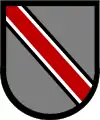
USACAPOC, 2nd PSYOP Group, 15th PSYOP BN's 346th Tactical PSYOP Co (original version) 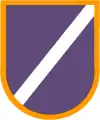
1st Special Forces CMD, 95th Civil Affairs BDE, 96th Civil Affairs BN's A Co
Engineer
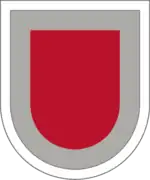
USAREUR-AF, 173rd Airborne BDE's 54th BDE Engineer BN 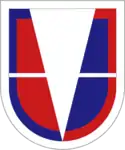
XVIII Airborne Corps, 20th Engineer BDE's 27th Engineer BN 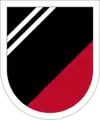
XVIII Airborne Corps, 20th Engineer BDE, 27th Engineer BN's 57th Engineer Co 
XVIII Airborne Corps, 20th Engineer BDE, 27th Engineer BN's 161st Engineer Co 
XVIII Airborne Corps, 20th Engineer BDE, 27th Engineer BN's 618th Engineer Co 
25th Infantry Div, 4th BCT's 6th BDE Engineer BN 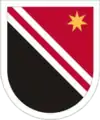
25th Infantry Div, 4th BCT, 6th BDE Engineer BN's 84th Engineer Co 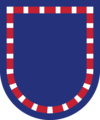
82nd Airborne Div, 1st BCT's 127th BDE Engineer BN 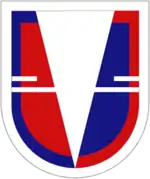
82nd Airborne Div, 2nd BCT's 37th BDE Engineer BN 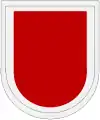
82nd Airborne Div, 3rd BCT's 307th BDE Engineer BN
- Obsolete engineer
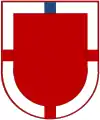
US Army Forces CMD's 20th Engineer BN 
XVIII Airborne Corps' 20th Engineer BDE (original version) 
XVIII Airborne Corps' 20th Engineer BDE 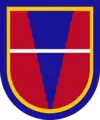
XVIII Airborne Corps, 20th Engineer BDE's 738th Engineer Co 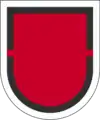
XVIII Airborne Corps, 20th Engineer BDE's 919th Engineer Co 
XVIII Airborne Corps, 20th Engineer BDE's 30th Engineer BN 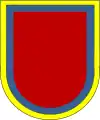
82nd Airborne Div's 127th Engineer BN (original version) 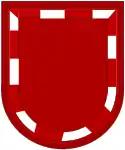
101st Airborne Div's 326th Engineer BN
Infantry

USAREUR-AF's 173rd Airborne BDE 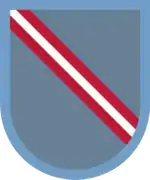
USAREUR-AF, 173rd Airborne BDE, 143rd Infantry RGT's, 1st BN 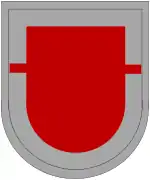
USAREUR-AF, 173rd Airborne BDE, 503rd Infantry RGT's 1st BN (formerly part of 101st Airborne Div's 3rd BCT) 
USAREUR-AF, 173rd Airborne BDE, 503rd Infantry RGT's 2nd BN (formerly part of 101st Airborne Div's 3rd BCT) 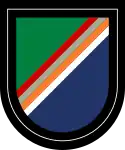
US Army Special Operations CMD's 75th Ranger RGT 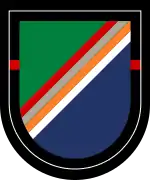
US Army Special Operations CMD, 75th Ranger RGT's 1st BN 
US Army Special Operations CMD, 75th Ranger RGT's 2nd BN 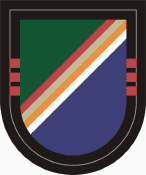
US Army Special Operations CMD, 75th Ranger RGT's 3rd BN 
25th Infantry Div's 4th BCT 
25th Infantry Div, 4th BCT, 501st Infantry RGT's 1st BN (formerly part of 101st Airborne Div's 2nd BCT) 
25th Infantry Div, 4th BCT, 509th Infantry RGT's 3rd BN 
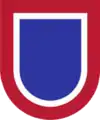
82nd Airborne Div 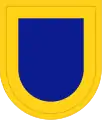
82nd Airborne Div's 1st BCT 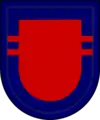
82nd Airborne Div, 1st BCT, 501st Infantry RGT's 2nd BN 
82nd Airborne Div, 1st BCT, 504th Infantry RGT's 1st BN 
82nd Airborne Div, 1st BCT, 504th Infantry RGT's 2nd BN 
82nd Airborne Div's 2nd BCT 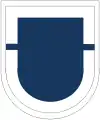
82nd Aiirborne Div, 2nd BCT, 325th Infantry RGT's 1st BN 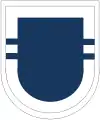
82nd Airborne Div, 2nd BCT, 325th Infantry RGT's 2nd BN 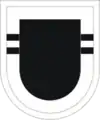
82nd Airborne Div, 2nd BCT, 508th Infantry RGT's 2nd BN 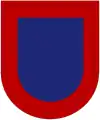
82nd Airborne Div's 3rd BCT 
82nd Airborne Div, 505th Infantry RGT's, 1st BN 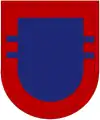
82nd Airborne Div, 3rd BCT, 505th Infantry RGT's 2nd BN 
82nd Airborne Div, 3rd BCT, 508th Infantry RGT's 1st BN
- Obsolete infantry
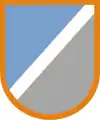
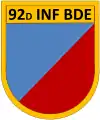
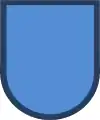
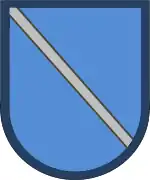
Texas Army National Guard, 36th Airborne Brigade, 143rd Infantry RGT's 1st BN 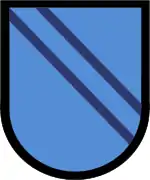
Texas Army National Guard, 36th Airborne Brigade, 143rd Infantry Regiment's 2nd BN 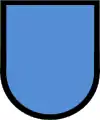
Texas Army National Guard's 1136th Infantry Detachment 
US Army Alaska, 172nd Infantry BDE, 9th Infantry RGT 4th BN's C Co 
US Army Alaska, 172nd Infantry BDE, 327th Infantry RGT, 4th BN's C Co 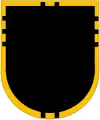
US Army Alaska, 172nd Infantry BDE, 327th Infantry RGT, 5th BN's C Co 
US Army Alaska, 172nd Infantry BDE, 327th Infantry RGT, 6th BN's C Co 
US Army Alaska, 207th Infantry Group's Long-Range Surveillance Detachment 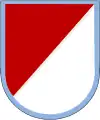
USAREUR-AF, 173rd Airborne BDE's 74th Infantry Detachment 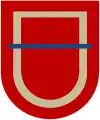
US Army South, 193rd Infantry BDE, 5th Infantry RGT, 3rd BN's A Co 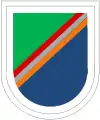
US Army Special Operations CMD, 75th Ranger RGT (original version) 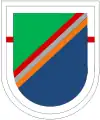
US Army Special Operations CMD, 75th Ranger RGT's 1st BN (original version) 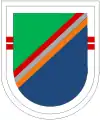
US Army Special Operations CMD, 75th Ranger RGT's 2nd BN (original version) 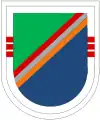
US Army Special Operations CMD, 75th Ranger RGT's 3rd BN (original version) 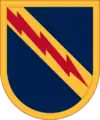
I Corps, 201st BfSB, 109th Military Intelligence BN, 52nd Infantry RGT's C Co 

26th Infantry Div's 173rd Infantry Detachment 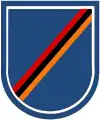
28th Infantry Div's 28th Infantry Detachment 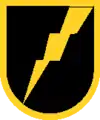
28th Infantry Div's 104th Infantry Detachment 
29th Infantry Div's 129th Infantry Detachment 
34th Infantry Div's 194th Infantry Detachment 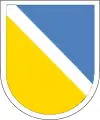
38th Infantry Div's 77th Infantry Detachment 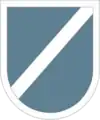
38th Infantry Div, 151st Infantry RGT's D Co 
40th Infantry Div's 76th Infantry Detachment 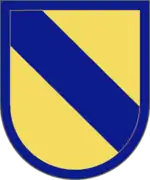
51st Infantry RGT's E Co (V Corps' 205th BfSB) and F Co (XVIII Airborne Corps' 525th BfSB) 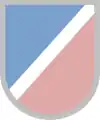
78th Troop CMD, 122nd Infantry RGT's H Co 
82nd Airborne Div's 1st BCT (original version) 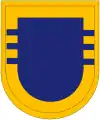
82nd Airborne Div, 1st BCT, 504th Infantry RGT's 3rd BN 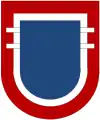
82nd Airborne Div's 2nd BCT (original version) 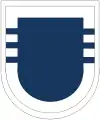
82nd Airborne Div, 2nd BCT, 325th Infantry RGT's 3rd BN 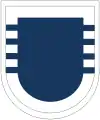
82nd Airborne Div, 2nd BCT, 325th Infantry RGT's 4th BN 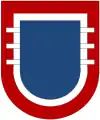
82nd Airborne Div's 3rd BCT (original version) 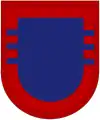
82nd Airborne Div, 3rd BCT, 505th Infantry RGT's 3rd BN 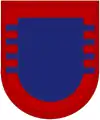
82nd Airborne Div, 3rd BCT, 505th Infantry RGT's 4th BN 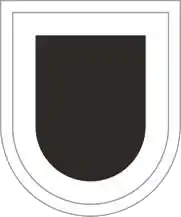
82nd Airborne Div's 4th BCT 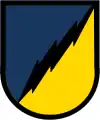
89th Army Reserve CMD's 26th Infantry Platoon 
96th Army Reserve CMD's 79th Infantry Platoon 
97th Army Reserve CMD's 5th Infantry Platoon 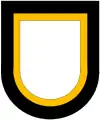
101st Airborne Div 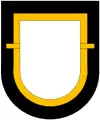
101st Airborne Div's 1st BCT 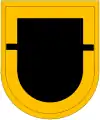
101st Airborne Div, 1st BCT, 327th Infantry RGT's 1st BN 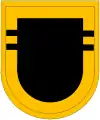
101st Airborne Div, 1st BCT, 327th Infantry RGT's 2nd BN 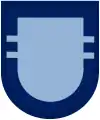
101st Airborne Div, 1st BCT, 502nd Infantry RGT's 2nd BN 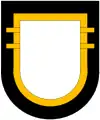
101st Airborne Div's 2nd BCT 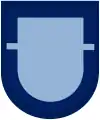
101st Airborne Div, 2nd BCT, 502nd Infantry RGT's 1st BN 
101st Airborne Div, 2nd BCT, 506th Infantry RGT's 1st BN 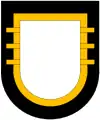
101st Airborne Div's 3rd BCT 
101st Airborne Div, 3rd BCT, 187th Infantry RGT's 3rd BN
Medical
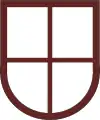
USAREUR-AF, 30th Medical BDE, 212th Combat Support Hospital's 67th Forward Resuscitative and Surgical Detachment 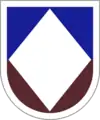
XVIII Airborne Corps, 44th Medical BDE, 28th Combat Support Hospital's 240th Forward Resuscitative and Surgical Detachment 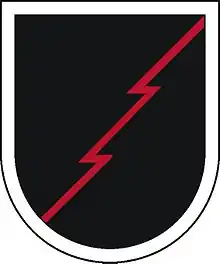
XVIII Airborne Corps, 44th Medical BDE, 28th Combat Support Hospital's 274th Forward Resuscitative and Surgical Detachment 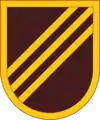
XVIII Airborne Corps, 44th Medical BDE, 28th Combat Support Hospital's 541st Forward Resuscitative and Surgical Detachment 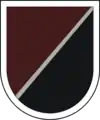
XVIII Airborne Corps, 44th Medical BDE, 28th Combat Support Hospital's 759th Forward Resuscitative and Surgical Detachment 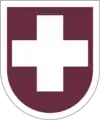
18th Medical CMD's 8th Forward Resuscitative and Surgical Detachment 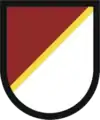
593rd Expeditionary Sustainment CMD, 62nd Medical BDE, 47th Combat Support Hospital's 250th Forward Resuscitative and Surgical Detachment
- Obsolete medical
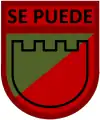
Puerto Rico National Guard's 292nd Medical BN or Co 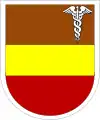
US Army Forces CMD's 86th Combat Support Hospital 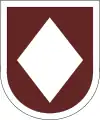
XVIII Airborne Corps's 44th Medical BDE 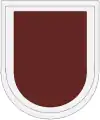
82nd Airborne Div, 307th Medical BN (currently the 82nd Airborne Div, 1st BCT's 307th BDE Support BN) 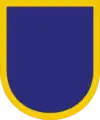
593rd Expeditionary Sustainment CMD, 62nd Medical BDE, 47th Combat Support Hospital's 250th Medical Detachment
Military intelligence
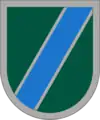
1st Special Forces CMD, 528th Sustainment BDE's 389th Military Intelligence BN
- Obsolete military intelligence

US Army Europe, 66th Military Intelligence BDE, 105th Military Intelligence BN's Long-Range Surveillance Detachment 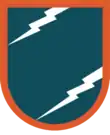
US Army Forces CMD's and 82nd Airborne Div's 313th Military Intelligence BN 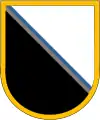
US Army South, 470th Military Intelligence BDE, 14th Military Intelligence BN's C Co 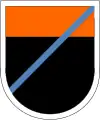
1st Cavalry Div, 312th Military Intelligence BN's Long-Range Surveillance Detachment 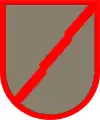
1st Infantry Div, 101st Military Intelligence BN, D Co's Long-Range Surveillance Detachment 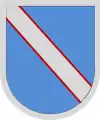
1st Special Forces' 297th Military Intelligence Detachment
as well as
XVIII Airborne Corps, 525th Military Intelligence BDE's 337th Military Intelligence BN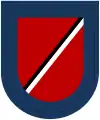
2nd Infantry Div, 2nd Div Support Group, 102nd Military Intelligence BN's Long-Range Surveillance Detachment 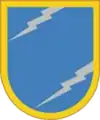
III Corps, 504th Military Intelligence BDE, 163rd Military Intelligence BN's Long-Range Surveillance Detachment 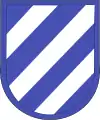
3rd Infantry Div, 103rd Military Intelligence BN's Long-Range Surveillance Detachment 
4th Infantry Div, 104th Military Intelligence BN's Long-Range Surveillance Detachment 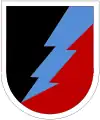
6th Infantry Div, 106th Military Intelligence BN, C Co's Long-Range Surveillance Detachment 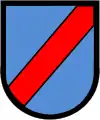
7th Infantry Div, 107th Military Intelligence BN's Long-Range Surveillance Detachment 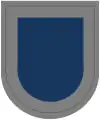
8th Infantry Div, 108th Military Intelligence BN's Long-Range Surveillance Detachment 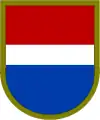
9th Infantry Div, 109th Military Intelligence BN, E Co's Long-Range Surveillance Detachment 
10th Mountain Div, 110th Military Intelligence BN's Long-Range Surveillance Detachment 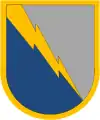
XVIII Airborne Corps's 525th Military Intelligence BDE 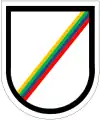
24th Infantry Div, 124th Military Intelligence BN's Long-Range Surveillance Detachment 
25th Infantry Div, 125th Military Intelligence BN's Long-Range Surveillance Detachment 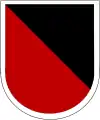
101st Airborne Div, 311th Military Intelligence BN's Long-Range Surveillance Detachment
Military police
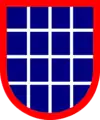
US Army Criminal Investigation CMD, 3rd Military Police Group's 10th Military Police BN 
XVIII Airborne Corps's 16th Military Police (MP) BDE 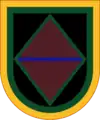
XVIII Airborne Corps, 16th MP BDE, 503rd MP BN's 21st MP Co 
XVIII Airborne Corps, 16th MP BDE, 503rd MP BN's 65th MP Co 
XVIII Airborne Corps, 16th MP BDE, 503rd MP BN's 108th MP Co 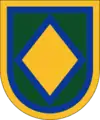
XVIII Airborne Corps, 16th MP BDE, 503rd MP BN's 118th MP Co
- Obsolete military police
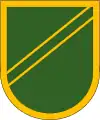
US Army Forces CMD's 553rd Military Police Co and 101st Airborne Div's 101st Military Police Co
Multidisciplinary units
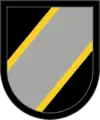
Joint Special Operations CMD–Army Element 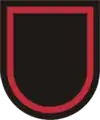
Special Operations CMD Africa-Army Element 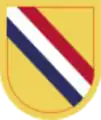
Special Operations CMD Central-Army Element 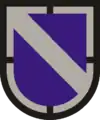
Special Operations CMD Europe-Army Element 
Special Operations CMD Korea-Army Element 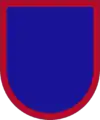
Special Operations CMD North-Army Element 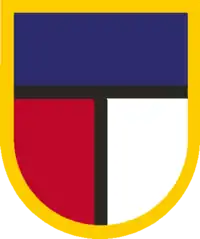
Special Operations CMD Pacific-Army Element 
Special Operations CMD South-Army Element 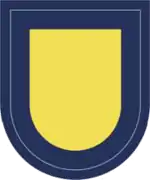
USAREUR-AF, 173rd Airborne BDE's 173rd BDE Support BN 
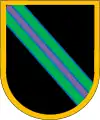

US Army Special Operations CMD 
US Special Operations CMD-Army Element 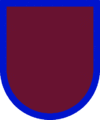
US Army Test and Evaluation CMD's Airborne and Special Operations Test Directorate 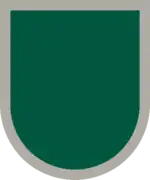
1st Special Forces CMD 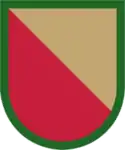
1st Special Forces CMD's 528th Sustainment BDE 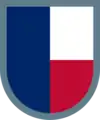
1st Special Forces CMD, 528th Sustainment BDE, Special Troops BN's 197th Special Troops Support Co 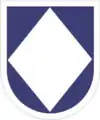
XVIII Airborne Corps 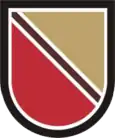
25th Infantry Div, 4th BCT's 725th BDE Support BN 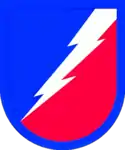
82nd Airborne Div's 82nd Airborne Div Sustainment BDE 
82nd Airborne Div, 1st BCT's 307th BDE Support BN (formerly the 82nd Airborne Div's 307th Medical BN) 
82nd Airborne Div, 2nd BCT's 407th BDE Support BN (formerly the 82nd Airborne Div's 407th Supply and Transportation BN) 
82nd Airborne Div, 3rd BCT's 82nd BDE Support BN 
82nd Airborne Div, CAB's 122nd Aviation Support BN
- Obsolete multidisciplinary units
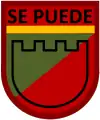
Puerto Rico National Guard's 292nd Combat Sustainment Support BN 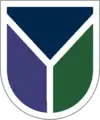
Special Operations CMD Joint Forces–Army Element 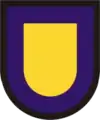
Special Operations Task Force Europe–Army Element 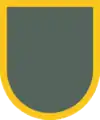
Supreme Headquarters Allied Powers Europe's Special Projects Branch–Army Element 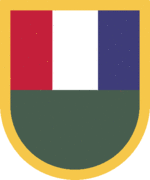
US Army Europe's Southern European Task Force 
US Army Airborne Board 
US Army Europe, 173rd Airborne BDE's Combat Support BN 
US Army Europe, 173rd Airborne BDE's Special Troops BN 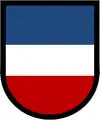
US Army Forces CMD 
US Army Garrision, Fort Bragg 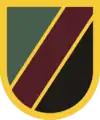
Special Operations Support CMD 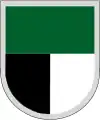
1st Special Operations CMD 

3rd Special Operations Support CMD 
4th Special Operations Support CMD 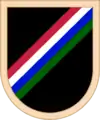
5th Special Operations Support CMD 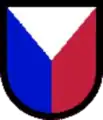
6th Special Operations Support CMD 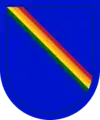
7th Special Operations Support CMD 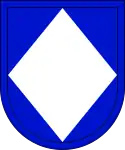
XVIII Airborne Corps (original version) 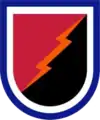
25th Infantry Div, 4th BCT's Special Troops BN 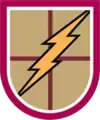
25th Infantry Div, 4th BCT's 167th Brigade Support BN 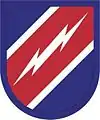
82nd Airborne Div's Special Troops BN 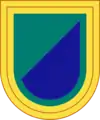
82nd Airborne Div, 1st BCT's Special Troops BN 
82nd Airborne Div, 2nd BCT's Special Troops BN 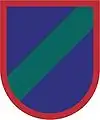
82nd Airborne Div, 3rd BCT's Special Troops BN 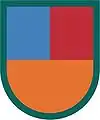
82nd Airborne Div, 4th BCT's Special Troops BN 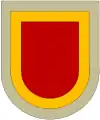
Signal
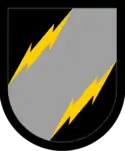
Joint Special Operations CMD's Joint Communications Unit–Army element 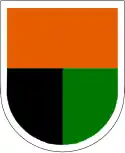
1st Special Forces CMD, 528th Sustainment BDE's 112th Special Operations Signal BN 
7th Signal CMD, 21st Signal BDE's 55th Signal Co 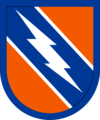
335th Theater Signal CMD, 359th Signal BDE's 982nd Signal Co
- Obsolete signal
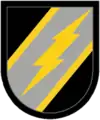
Joint Special Operations CMD's Joint Communications Unit–Army element (original version) 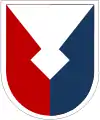
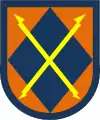
XVIII Airborne Corps's 35th Signal BDE 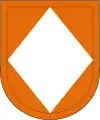
XVIII Airborne Corps, 35th Signal BDE's 50th Signal BN 
XVIII Airborne Corps, 35th Signal BDE's 51st Signal BN 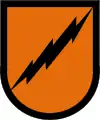
XVIII Airborne Corps, 35th Signal BDE's 327th Signal BN (original version) 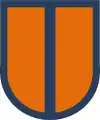
XVIII Airborne Corps, 35th Signal BDE's 327th Signal BN 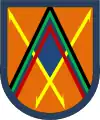
XVIII Airborne Corps, 35th Signal BDE's 426th Signal BN 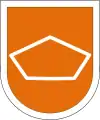
82nd Airborne Div's 82nd Signal BN 
101st Airborne Div's 501st Signal BN 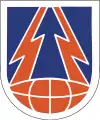
335th Theater Signal CMD, 359th Signal BDE's 982nd Signal Co (original version)
Special forces
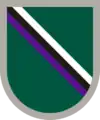
Special Forces personnel in non-special operations units 
1st Special Forces CMD's 1st Special Forces Group 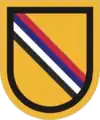
1st Special Forces CMD, 1st Special Forces Group's 39th Special Forces Detachment 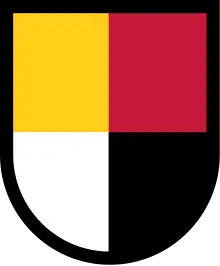
1st Special Forces CMD's 3rd Special Forces Group 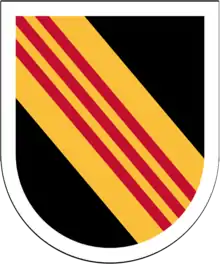
1st Special Forces CMD's 5th Special Forces Group 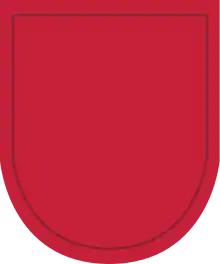
1st Special Forces CMD's 7th Special Forces Group 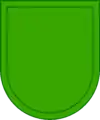
1st Special Forces CMD's 10th Special Forces Group 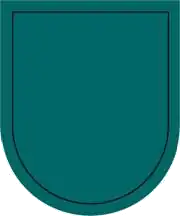
1st Special Forces CMD's 19th Special Forces Group 
1st Special Forces CMD's 20th Special Forces Group
- Obsolete special forces

Special Forces personnel assigned to the Joint Chiefs of Staff 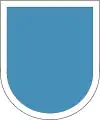
1st Special Forces's Special Forces Reserve 
1st Special Forces, Special Forces Reserve's Recognition Bar 
1st Special Forces, 1st Special Forces Group's Recognition Bar 
1st Special Forces, 3rd Special Forces Group's Recognition Bar 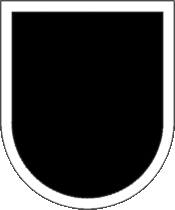
1st Special Forces' 5th Special Forces Group (original version) 
1st Special Forces, 5th Special Forces Group's Recognition Bar 
1st Special Forces, 5th Special Forces Group–Vietnam's Recognition Bar 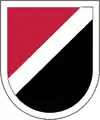
1st Special Forces' 6th Special Forces Group 
1st Special Forces, 6th Special Forces Group's Recognition Bar 
1st Special Forces, 7th Special Forces Group's Recognition Bar 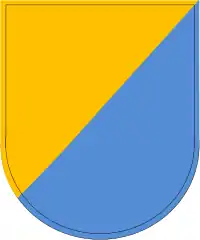
1st Special Forces' 8th Special Forces Group 
1st Special Forces, 8th Special Forces Group's Recognition Bar 
1st Special Forces, 10th Special Forces Group's Recognition Bar 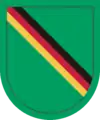
1st Special Forces, 10th Special Forces Group's Special Forces Detachment-Europe 
1st Special Forces, 10th Special Forces Group's Special Forces Detachment-Europe Recognition Bar 
1st Special Forces' 11th Special Forces Group 
1st Special Forces, 11th Special Forces Group's Recognition Bar 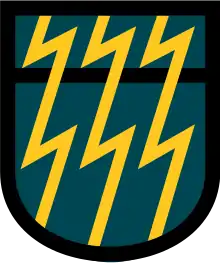
1st Special Forces' 12th Special Forces Group 
1st Special Forces, 12th Special Forces Group's Recognition Bar 
1st Special Forces, 19th Special Forces Group's Recognition Bar 
1st Special Forces, 20th Special Forces Group's Recognition Bar
Training
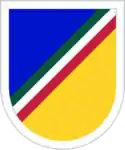
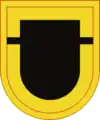
Joint Readiness Operations Group, 509th Infantry RGT's 1st BN 
Quartermaster Center and School's Aerial Delivery & Field Services Department 
Quartermaster Center and School's 262nd Quartermaster BN 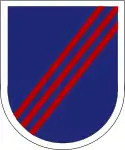
SFAC 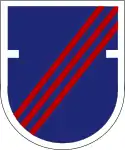
SFAC's 1st SFAB 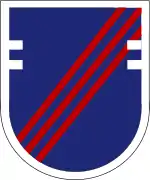
SFAC's 2nd SFAB 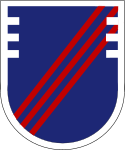
SFAC's 3rd SFAB 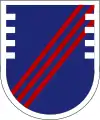
SFAC's 4th SFAB 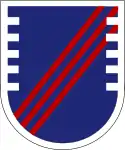
SFAC's 5th SFAB 
SFAC's 54th SFAB 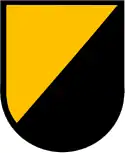
US Army Infantry School's Airborne and Ranger Training BDE 
US Army Infantry School, Airborne and Ranger Training BDE, 507th Infantry RGT's 1st BN 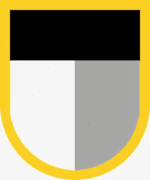

SWCS's David K Thuma NCO Academy 
SWCS's Special Forces Warrant Officer Institute 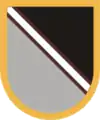
SWCS's Special Warfare Medical Group 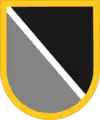
SWCS's 1st Special Warfare Training Group 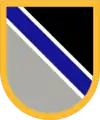
SWCS's 2nd Special Warfare Training Group 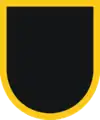
US Army Junior Reserve Officers' Training Corps 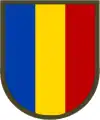
US Army Training and Doctrine CMD's Airborne/Airlift Action Office 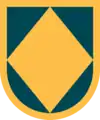
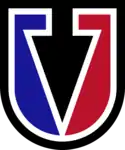
82nd Airborne Div's Advanced Airborne School
- Obsolete training

Fort Irwin National Training Center's Light Infantry and Task Force Observer/Controller Team 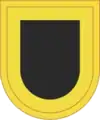
Joint Readiness Operations Group, 509th Infantry RGT's 1st BN (original version)
as well as
509th Infantry RGT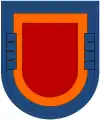

US Army Academy of Health Sciences, Academy BDE, 3rd BN's F Co (Special Forces Medic School) 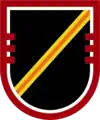
US Army Armor School, 16th Cavalry RGT, 3rd SQN's D Co (Reconnaissance and Surveillance Leaders Course) 
US Army Aviation Center and School, 509th Infantry's C Co (Pathfinder) 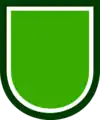
US Army Aviation Center and School, 511th Infantry RGT's A Co (Pathfinder) 
US Army Aviation Center and School, 1st Aviation BDE's 187th Infantry Detachment (Pathfinder) 
US Army Infantry School's Airborne Department 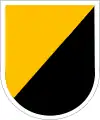
US Army Infantry School's Ranger Training BDE (original version) 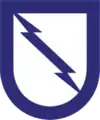
US Army Infantry School, 507th Infantry RGT's 1st BN (original version) 
US Army School of the Americas' Special Operations and Civil Military Operations Department 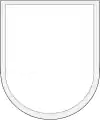
SWCS's Special Forces Training Group 
SWCS, Special Forces Training Group's Recognition Bar 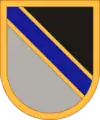
SWCS's Special Warfare Education Group 
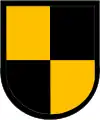
US Army Reserve Officers' Training Corps's Senior Ranger Challenge Team 
US Military Academy's Airborne Detachment 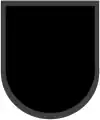
101st Airborne Div's Screaming Eagle Replacement Training School
Beret flashes of the US state defense forces
State defense forces—also known as state guard, state military reserve, or state militia—in many US states and territories wear modified versions of US Army uniforms.[45][127][128] To help separate these state guard members from other federal armed forces, such as the US National Guard, some will wear a unique organizational beret flash on their military beret.[45][129][130][131][132][133][134][135] The following is a list of some of these organizational beret flashes worn by various state military reserve units:
State Defense Force (worn by various state militias)
State specific



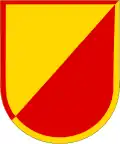
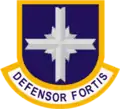
Puerto Rico State Guard, Air Div, 1st Air Base Group's Security Forces 
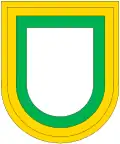
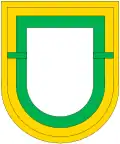
Washington State Guard's 1st BDE 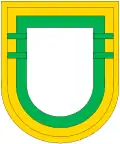
Washington State Guard's 2nd BDE
- Obsolete state specific

District of Columbia Defense Force
See also
References
- Department of the Army Pamphlet 670–1, Uniform and Insignia Guide to the Wear and Appearance of Army Uniforms and Insignia, Department of the Army, dated 26 January 2021, last accessed 27 January 2021
- Air Force Instruction 36-2903, Dress and Personal Appearance of Air Force Personnel, Department of the Air Force, dated 7 February 2020, corrected 2 July 2020, last accessed 14 November 2020
- US Army / US Army Heraldry / Beret Flash and Background Trimmings, The Institute of Heraldry, last accessed 12 February 2020
- Army contributions to U.N. Liberia mission significant, former force chief says, Army.mil, by Lisa A. Ferdinando, dated 20 September 2013, last accessed 28 April 2018
- War Eagle Troopers receive Multinational Force and Observers medal, Army.mil, by MAJ Michael Soyka and SGT William A. Tanner, dated 9 May 2016, last accessed 28 April 2018
- Joint Communications Support Element–Government Organization, official Facebook page, last accessed 20 January 2021
- Quiet Professionals don brown beret, US Air Force Special Operations Command, by Capt Monique Roux, dated 8 January 2018, last accessed 28 April 2018
- All American Legacy Podcast Ep 25 - The French Hat, 82nd Airborne Division Official YouTube Channel, dated 26 June 2017, last accessed 24 March 2020
- The colorful and controversial history of the Army's berets, ConnectingVets.Radio.com, by Jack Murphy, dated 23 October 2019, last accessed 18 January 2020
- AR 670-1 1981 (OBSOLETE) : Wear and appearance of Army uniforms and insignia, Department of the Army via Ike Skelton Combined Arms Research Library Digital Library, dated 1 November 1981, last accessed 21 November 2020
- The 505th Parachute Infantry Regiment, Unit History, ww2-airborne.us, last accessed 3 July 2018
- Army Regulation 670-1, Wear and Appearance of Army Uniforms and Insignia Headquarters Department of the Army, dated 22 May 2000, last accessed 3 July 2018
- Other Insignia not Shoulder Sleeve Insignia, Garrison Cap Insignia of Airborne Units, Second World War, Angelfire.com, by Dr. Howard G. Lanham, dated 2001, last accessed 4 July 2019
- Army Regulation 670-1, Wear and Appearance of Army Uniforms and Insignia Headquarters Department of the Army, dated 1 July 2002, last accessed 3 July 2018
- History of the Army Beret, CSA SENDS - THE ARMY BLACK BERET, armyreal.com, last accessed 12 February 2020
- Big Picture: Pictorial Report No. 29, US Army's The Big Picture (TV-372), from PublicResourceOrg YouTube Channel, dated 1956, posted 14 November 2010, last accessed 31 May 2020
- Big Picture: Silent Warriors, US Army's The Big Picture (TV 518), from PublicResourceOrg YouTube Channel, dated 1961, posted 12 November 2010, last accessed 4 May 2020
- Special Forces, US Army's The Big Picture (TV-547), from PublicResourceOrg YouTube Channel, dated 1962, posted 6 January 2010; last accessed 4 May 2020
- MG Chester Victor Clifton, Jr, Find a Grave, Memorials, dated 26 Jan 2008, last accessed 4 April 2019
- The Beret in U.S. Military Uniform History, The Balance Careers, by Rod Powers, updated 27 June 2019, last accessed 14 September 2019
- A Short History of the Use of Berets in the U.S. Army, army.mil via WebArchive, dated 03 November 2000, last accessed 26 March 2019
- US Army Special Forces 1952–84, Bloomsbury Publishing, by Gordon L. Rottman, dated 20 September 2012, ISBN 9781782004462, last accessed 29 March 2019
- Army Regulation 614–200, Enlisted Assignments and Utilization Management, Department of the Army, dated 25 January 2019, last accessed 30 May 2020
- SF History–Special Forces: The Early Years, Special Forces Association, last accessed 29 April 2020
- U.S. Army, Japan Shoulder Sleeve Insignia, US Army Institute of Heraldry, dated 3 April 1959, last accessed 29 April 2020
- Keith Allen Campbell; Specialist Four; Headquarters and Headquarters Company, 1st Battalion, 503rd Infantry, 173rd Airborne Brigade, US Army Reserve; Army of the United States, Arlington, Virginia; March 03, 1946 to February 08, 1967; The Virtual Wall, Vietnam Veterans Memorial; last updated 15 August 2019, last accessed 14 November 2020
- Utrikestjänst, CA besök i USA. Fort Bragg, Digitaltmuseum.se, by SP4 Laverne Fultz (US Army), dated 28 May 1975, last accessed 19 December 2020
- US Army berets - blue, black, green, maroon, tan..., The US Militaria Forum, last accessed 16 October 2020
- Airborne and Ranger Training Brigade (ARTB), Graduates, 1971, Class 11-1971, benning.army.mil, dated 1971, last accessed 13 June 2020
- History of the Black Beret, Army Study Guide, by SMA Jack L. Tilley, last accessed 23 December 2020
- Insignia of Airborne Units, U.S. Army, Second World War, Airborne Breast Oval Background Trimmings, American Military Patches, Other Insignia and Decorations of World War Two, by Dr. Howard G. Lanham, dated 2001, last accessed 24 June 2017
- Stories of Honor: Dan McKinney follows in father's footsteps with Vietnam service, From the Stories of Honor: Honoring Helena-area veterans across generations series, Independent Record, by Curt Synness, dated 22 July 2019, lasted accessed 30 March 2020
- Robert Wolfe served in the U.S. Army, 82nd Airborne/1st Ranger Battalion, archives.hunaheritage.org, dated 28 February 1973, last accessed 14 November 2020
- A member of Company B, 2nd Brigade, 82nd Airborne Division, prepares for a troop drop during Exercise NEPTUNE II, Defense Audiovisual Agency, National Archives (locator: 6375832 and local identifier: 330-CFD-DF-SN-84-04750.jpeg), dated 20 August 1977, last accessed 19 December 2020
- Welcome to the 101st Airborne Division (Air Assault), Army.mil, by 101st Airborne Division Public Affairs Office, dated 2 April 2014, last accessed 25 January 20212
- Qualification Badges, Air Assault Badge, US Army Institute of Heraldry, dated 18 January 1978, last accessed 16 October 2020
- On episode 25 of the All American Legacy Podcast, we mention the blue beret of the 101st Airborne Division in the 1970s. Well, here is the proof., 82nd Airborne Division official Facebook page, dated 28 June 2017, last accessed 23 March 2020
- The Black Beret, Tanker's Jackets and Gunnery Qualification Patches: Scouts Out ... Fashion Forward, The Hidden Stories: 1970s - From Starch to Permanent Press, Eaglehorse.org, last accessed 6 May 2020
- Army Regulation 670–1 (2002), Uniforms and Insignia, Wear and Appearance of Army Uniforms and Insignia, Department of the Army, dated 1 July 2002, last accessed 22 April 2020
- Operation Urgent Fury (Grenada) (US Military photo gallery), PBase.com, by Oly Olson, last accessed 4 July 2018
- FAQs-Organizational Insignia, The US Army Institute of Heraldry, last accessed 19 May 2020
- Beret Flash for the 1st Security Force Assistance Brigade; Department of the Army, The Institute of Heraldry; AAMH-IHS; dated 9 February 2018; last accessed 14 April 2020
- 1st SFAB hosts activation ceremony; Heraldry announced, Army.mil, by US Army, dated 8 February 2018, last accessed 29 December 2020
- Youngest Beret, 1st Battalion, 23rdInfantry Regiment, Fort Lewis's 23rd Infantry Regiment official homepage, last updated 15 July 2002, last accessed 29 December 2020
- Army Regulation 670–1 (2017), Uniform and Insignia Wear and Appearance of Army Uniforms and Insignia, Department of the Army, dated 25 May 2017, last accessed 4 July 2017
- Beret Flash, U.S. Army, A-4-187 (manufacturing production sheet), US Army Institute of Heraldry (courtesy of Eagles of War), dated 22 November 2000, last accessed 11 June 2020—a copy is also available on Wikimedia Commons at File:US Army TIOH Manufacturing Instructions Sheet-Army Flash.png
- Clothing and Heraldry PSID, US Army TACOM Life Cycle Management Command, last accessed 8 September 2019
- Authorized Insignia for the Security Force Assistance Command; Department of the Army, The Institute of Heraldry; AAMH-IHS; dated 16 November 2018; last accessed 14 April 2020
- Beret Flash for the 2d Security Force Assistance Brigade; Department of the Army, The Institute of Heraldry; AAMH-IHS; dated 7 June 2018; last accessed 14 April 2020
- Beret Flash for the 3d Security Force Assistance Brigade; Department of the Army, The Institute of Heraldry; AAMH-IHS; dated 8 August 2018; last accessed 14 April 2020
- Authorized Insignia for the 4th Security Force Assistance Brigade; Department of the Army, The Institute of Heraldry; AAMH-IHS; dated 8 January 2019; last accessed 14 April 2020
- Authorized Insignia for the 5th Security Force Assistance Brigade; Department of the Army, The Institute of Heraldry; SAAA-IHS; dated 31 July 2019; last accessed 14 April 2020
- Authorized Insignia for the 54th Security Force Assistance Brigade; Department of the Army, The Institute of Heraldry; SAAA-IHS; dated 2 December 2019; last accessed 5 June 2020
- U.S. Army Beret Flash, The US Army Institute of Heraldry, dated 20 November 2000, last accessed 1 February 2021
- Big Picture: Your Army Reports: Number 10, US Army's The Big Picture (TV 713), hosted on PublicResourceOrg YouTube Channel, dated 1967, posted 31 December 2010, last accessed 19 May 2020
- Beret Flash and Background Trimming for the 346th Quartermaster Company; Department of the Army, The Institute of Heraldry; SAAA-IHS; dated 16 December 2019; last accessed 6 June 2020
- TIOH Organization, The US Army Institute of Heraldry, last accessed 19 May 2020
- AIRMAN 1ST Class Lisa Krawchenko, a law enforcement specialist at George Air Force Base, Calif. Krawchenko recently completed a temporary assignment with the investigations section at Howard Air Base, Panama, National Archives Catalog, by TSgt Fernando Serna (US Air Force), dated 16 February 1990, last accessed 14 November 2020
- USAF Safeside (Part 1 of 2), US Air Force, hosted of Krpinckney YouTube Channel—video extract available on Commons—posted 12 November 2009, last accessed 7 May 2020
- Defensor Fortis: A Brief History of USAF Security And Those Dedicated Few Who Defend The Air Force At The Ground Level (pages 37–38), Universal Publishers Press, by Kali Pinckney, dated 1 November 2003, last accessed 5 July 2018
- SAC Elite Guard History, The Real History of the Air Force Blue Beret, by Col Ray Balcer (USAF), dated April 2005, last accessed 5 July 2018
- History of the Security Police Beret, by Safeside Association, last accessed 5 July 2018
- USAF Security Police Squadrons in Vietnam, usmilitariaforum.com, posted 22 March 2009, last accessed 14 July 2017
- Brothers in Berets, The Evolution of Air Force Special Tactics, 1953-2003; Air University Press, Curtis E. LeMay Center for Doctrine Development and Education, Maxwell Air Force Base, Air Force History and Museums Program, in conjunction with Air Force Special Operations Command; by Forrest L. Marion, PhD; dated January 2018; last accessed 1 April 2020
- The Story of America's Peacekeepers and Her Defenders, USAF Police Alumni Association—information provided by the Security Forces Training Center—last accessed 7 May 2020
- SgtMacsBar–CCT in Japan, sgtmacsbar.com, last accessed 31 March 2020
- This Gallery Is To Inform You Of The Most Recent Passing Of Those Within Our Brotherhood, I'm So Sorry!; MKP Air Base Thailand, May 1967, sgtmacsbar.com, last accessed 17 July 2017
- Distinctive Beret Uniform History of U.S. Armed Services, afspecialwarfare.com, by MSgt John Cassidy (Ret.), dated 24 July 2012, last accessed 15 May 2020
- Lee-Jackson Militaria, Air Control & Support Units–Combat Control Team, Flash/Qualification Badge, ljmilitaria.com, last accessed 19 July 2020
- A close-up view of the badge pinned to the beret of a combat control team member, US National Archives Catalog, dated 1 November 1983, last accessed 14 November 2020
- Combat Control Memorial, Remembering Our Fallen Brothers, Combat Control Memorial via Wayback Machine, dated 6 April 2019, last accessed 19 July 2020
- Air Force Special Operations Command - Art - Media Gallery - Page 6, US Air Force Special Operations Command, dated 9 November 2005, last accessed 19 July 2020
- Join Special Tactics, US Air Force Special Operations Command, archive date 2 January 2013, last accessed 9 May 2020
- Special Tactics Officer and Combat Rescue Officer Application–FY2020 US Air Force, last accessed 5 April 2020
- Combat Search and Rescue in Southeast Asia, National Museum of the US Air Force, dated 18 May 2015, last accessed 17 July 2017
- Meaning behind the scarlet red beret, Air Force Special Warfare Frum, dated 12–24 April 2019, last accessed 15 May 2020
- BILL STEFFENS, WWII, KOREAN WAR, COLD WAR, Petoskey Veteran’s logo design has graced air rescue units for over 60 years, and he just found out about it; Emmet County, Michigan, Veterans Stories; by Tamara Stevens; dated 28 February 2014; last accessed 15 May 2020
- Pararescuemen: Honoring fallen warriors, af.mil, by SSgt Mareshah Haynes (Defense Media Activity), dated 22 June 2010, last accessed 2 April 2020
- Special Operations Weather Team, AFSOC, dated 12 August 2014, last accessed 14 November 2020
- Air Force Weather, Our Heritage 1937 to 2012, prepared by TSgt C. A. Ravenstein (Historical Division, AW3DI, Hq AWS), dated 22 January 2012, last accessed 14 March 2020
- Special Operations Weather Technicians and Officers, National Museum of the United States Air Force, dated 2 June 2015, last accessed 16 March 2020
- Earning the gray beret, Keesler Air Force Base public website, dated 10 June 2008, last accessed 18 July 2017
- Christian Shepherd, 18th Weather Squadron Combat Weatherman, flickr.com, dated 7 October 2007, last accessed 18 July 2017
- STS kicks off Kadena’s remembrance ceremony, 353sog.af.mil, by SSgt Christopher Hummel, dated 12 November 2010, last accessed 8 March 2020
- Special Operations Weather Team Recruiting Facebook page, Facebook, dated 9 December 2010, last accessed 18 July 2017—Image of the SOWT beret and beret flash from this website is available on Commons
- New USAF Special Warfare Symbol, soldiersystems.net, dated 3 July 2019, last accessed 11 December 2019
- Spec ops weathermen get name change, new mission to better fight great powers, AirForceTimes, by Kyle Rempfer, dated 13 May 2019, last accessed 16 September 2019
- Air Force Report: Combat Weathermen, Defense Visual Information Distribution Service, by TSgt Ron Rogers (U.S. Air Force), dated 11 October 2007, last accessed 24 June 2020
- STS kicks off Kadena’s remembrance ceremony, 353rd Special Operations Group official homepage, by SSgt Christopher Hummel (18th Wing Public Affairs, U.S. Air Force), dated 12 November 2010, last accessed 24 June 2020
- TACP - Flash and Crest Heraldry, unknown author but suspected to be US Air Force, hosted on ClearedHotProduction YouTube Channel, posted 20 March 2012, last accessed 31 May 2020
- 274th ASOS Change-of-Comand and Ribbon Cutting Ceremonies, 174attackwing.ang.af.mil, by SSgt James N. Faso, dated 4 June 2011, last accessed 8 March 2020
- AFSC 13LX Air Liaison Officer, Career Field Education and Training Plan, Department of the Air Force, dated 21 May 2013, last accessed 5 March 2020
- TACP Officer Assessment and Selection, Application Process, airforce.com, dated FY2020, last accessed 7 March 2020
- "Garand Thumb," a US Air Force Air Liaison Officer and YouTuber, photographed in his service dress uniform, Facebook, public access photo (unrestricted), dated 27 September 2019, last accessed 30 December 2019
- U.S. Army Europe, Clearing the DZ, US Army Europe Flickr page, dated 29 September 2011, last accessed 7 May 2020
- USAF, Air Mobility Liaison Officer, A-4-299, The Institute of Heraldry via the Eagles of War website, dated 20 January 2015, last accessed 14 March 2020
- More than a pilot: providing air support from the ground, US Air Force, by A1C Daniel Phelps (20th Fighter Wing Public Affairs), dated 23 June 2011, last accessed 20 May 2020
- Airman Magazine of the United States Air Force, Developing Airman (see page 31), U.S. Air Force, dated January-February 2009, last accessed 25 July 2020
- SERE graduates authorized berets, US Air Force, by A1C Nathan Putz (92nd Air Refueling Wing Public Affairs), dated 14 December 2004, last accessed 17 June 2018
- Quiet Professionals don brown beret, AFSOC, by Capt Monique Roux (919th Special Operations Wing Public Affairs), dated 8 January 2018, last accessed 5 July 2018
- River Patrol Force/River Patrol Flotilla Five (TF-116), Operation Game Warden, 8 November 1967 - 3 November 1968, by Thomas W. Glickman, dated 14 July 2008, last accessed 24 October 2018
- NH 69307 Uniform, Naval History and Heritage Command, last accessed 13 April 2019
- The Gamewardens Association, Vietnam to Present, Official home of Task Force 116 and the Brown Water Navy, last accessed 16 January 2021
- US Navy Riverines wearing berets now?, SNAFU!, by "Solomon," dated 7 November 2014, last accessed 24 October 2018
- 428-GX-USN 1142474, National Archives (2016/04/12)—hosted on Photograph Curator's Flickr page—by PH2 S.P. Langley (US Navy), dated August 1969, last accessed 7 May 2020
- CONCENTRATION (Part I), "HOLD and DIE!"; Voice of the Soldier, Official News Letter of SpecialForces.com; dated November 2009, last accessed 14 November 2020
- Col. John W. Ripley: Uncommon Valor, nobility.org, by Jeremias Wells, dated 28 October 2013, last accessed 18 April 2020
- From the ‘WAF’ to the Guard, a woman reflects on her Air Force career; US Air Force; by 2nd Lt. Angela Walz, 162nd Fighter Wing Public Affairs; dated 26 February 2010, last accessed 12 April 2019
- USMC Women's Service & Dress Caps, US Militaria Forum, started by "usmc-collector" on 19 August 2013, last accessed 12 April 2019
- NAVADMIN 208/15, Department of the Navy, dated 1 September 2015, last accessed 30 August 2019
- Appendix–D, Women's Army Corps Uniforms 1942–1978, University of Göttingen, last accessed 12 May 2019
- Class A Service and Dress From Uniforms From 1970's-2000; US Army Medical Department, Office of Medical History; last modified 2 July 2009, last accessed 20 May 2020
- Service Dress Coat Uniform,Winter USAF Blue Shade 84, Service Dress 1949–1965, USAF FLag Ranks, by: Bro John Schlund, last updated 22 January 2010, last accessed 13 April 2019—Note: This is the only information found on what Air Force warrant officers wore as their headgear device and based on US military tradition, it is assumed that this device was also used on the Air Force female service uniform beret.
- Origin of the Eagle Rising, Original Distinctive Insignia of the Army Warrant Officer, Warrant Officer Historical Foundation, last updated 1 June 2015, last accessed 21 August 2019
- Air Force Junior Reserve Officer Training (AFJROTC) PA-20051 Nighthowks Cadet Guide (Attachment 7-5, Cadet Beret Headgear), dated 2019-2020, last accessed 30 January 2021
- Beret Flashes and Background Trimmings in Alphabetica Order with TIOH Drawing Numbers, Eagles of War, last accessed 30 January 2021
- U.S. Special Forces, Special Operations Forces and Airborne Units Insignia, Beret Flashes, United States Military Insignia, last accessed 4 January 2021
- 101st Airborne Division Blue Air Assault Beret 1973-1978, U.S. Militaria Forum, last accessed 25 January 2021
- Evaluation of Department of Defense Interaction with State Defense Forces, Report No. DODIG-2014-065, Department of Defense Office of Inspector General, dated 30 April 2014, last accessed 26 May 2020
- SDF Times, Spring 2017, State Guard Association of the United States, dated 2017, last accessed 3 May 2020—Note page 36 which pictures a Mississippi State Guardsman wearing the SDF Beret Flash
- Wear and Appearance of California State Military Reserve Uniforms and Insignia, California State Military Reserve Regulation 670-1 and Instruction 36-2903, California State Military Reserve, dated 1 April 2008, last accessed 1 May 2020
- Wear and Appearance of Uniforms and Insignia, Georgia State Defense Force Regulation 670-1, Georgia State Defense Force, dated 15 November 2009, last accessed 1 May 2020 (alternate source if required:)
- Authorized Headgear-NYGD1334.1, New York Guard, dated 1 March 2015, last accessed 3 May 2020
- Wear and Appearance of Uniforms and Insignia, Ohio Military Reserve Regulation 670-1, Ohio Military Reserve, dated 1 May 2012, last accessed 1 May 2020
- Wear and Appearance of Virginia Defense Force Uniforms and Insignia, Virginia Defense Force Regulation 670-1, Virginia Defense Force, dated 1 February 2016, last accessed 1 May 2020
- State Guard Units (starts at post #89), The US Militaria Forum, last accessed 30 January 2021
- Districted of Colombia Defense Force, Commanding Generl Major General Reeder, Districted of Colombia Defense Force official Facebook page, dated 7 April 2014, last accessed 30 January 2021
Further reading
- U.S. Army Patches, Flashes, and Ovals: An Illustrated Encyclopedia of Cloth Unit Insignia, by Barry Jason Stein, published by Insignia Ventures, dated 2007, ISBN 9780979161308
- Beret Insignia of the U.S. Army; by William A Hudspeath; published by Richard W Smith, Hendersonville; dated 1997; ASIN B06XD7DSY9
